Sites: news | india | latam | brasil | indonesia
Feeds: news | india | latam | brasil | indonesia
topic: Traditional Chinese Medicine
Social media activity version | Lean version
It’s tough to be a wild orchid: Interview with conservation biologist Reshu Bashyal
- Conservation biologist Reshu Bashyal highlights gaps in Nepal’s implementation of CITES regulations, leading to ineffective protection measures.
- Nepal’s transition to a federal system has brought challenges and opportunities for orchid conservation, with local communities often unaware of conservation needs.
- Protected areas struggle to prioritize plant conservation alongside charismatic megafauna, while road construction further fragments orchid habitats.
- Bashyal emphasizes the importance of raising awareness about the significance of wild plants and updating inventories to guide conservation efforts.
When it rains, it pours: Bangladesh wildlife trade booms during monsoon
- The illegal wildlife trade in Bangladesh increases during the wet season due to a shortage of livelihoods and poor surveillance, a study has found.
- Killing and trading wildlife has been illegal in Bangladesh since 2012, but a culture of hunting means the problem still persists, wildlife officials say.
- Wildlife markets trade in animals and parts from species such as tigers and crocodiles, with the more lucrative end of the trade thriving in areas with a weak law enforcement presence and close proximity to a seaport or airport.
- Efforts to tackle the trade are limited by law enforcement restrictions, with the Wildlife Crime Control Unit (WCCU) lacking the authority to arrest suspects and reliant on local agencies for investigations and legal action.
Rumors and misconceptions threaten tokay geckos in Bangladesh
- Widespread misconceptions about the medicinal benefits of tokay geckos are leading to these common nocturnal lizards being hunted across Bangladesh.
- Wildlife traffickers set an exorbitant price on trapped geckos, based on rumors about their international demand. There is no documented evidence that buyers pay a high price for geckos.
- In the last five years, more than 250 geckos were recovered and more than 30 suspected wildlife smugglers arrested. In Bangladesh, a study found that gecko populations are estimated to have declined by 50% due to trade on the international market based on claims that the species holds medicinal qualities.
- Tokay geckos maintain ecosystem balance by preying on invertebrates, including moths, grasshoppers, beetles, termites, crickets, cockroaches, mosquitoes and spiders.
Illegal orchid trade threatens Nepal’s ‘tigers of the plant world’
- Roughly 500 orchid species grow in Nepal’s forests, including a rare pale purple beauty that attracts thousands of pilgrims each April.
- Orchids are among the most diverse and charismatic plant groups in the world, and they are threatened by illegal and unsustainable trade, largely for Ayurvedic and Chinese medicine.
- Kathmandu-based NGO Greenhood Nepal has a project that outlines key steps for government agencies to take in efforts to curb illegal and unsustainable trade in Nepal’s orchids.
Local coverage of Nepal’s ‘Himalayan Viagra’ harvest lacks eco focus, study says
- Yarsa gunbu, better known outside Nepal as the Himalayan Viagra, accounts for two-fifths of the country’s non-timber exports.
- Every year, hundreds of thousands of Nepalis head for the hilly regions to harvest this fungus-mummified caterpillar larvae from the wild, leaving schools, farms and entire villages deserted.
- A new study analyzing domestic news coverage of yarsa gunbu has found that much of the reporting focuses on the scale of the harvest and the exorbitant prices that the commodity can fetch.
- The study authors have called on the media to emphasize other aspects of the yarsa gunbu trade, including the ecological cost from harvesting, and the social cost when schools are bereft of teachers.
A fast-growing pipeline: The Amazon-to-Southeast Asia wildlife trade
- The legal and illegal wildlife trade continues to escalate in tandem with increasing Chinese investment in South America’s Amazon region, mirroring a similar China trafficking trend that devastated elephants, rhinos and pangolins in Africa.
- Hundreds of Amazon species are being shipped to Asia, principally China, in unsustainable numbers, ranging from jaguars to reptiles, turtles and parrots to songbirds, poison dart frogs and tropical fish. The damage to the Amazon biome could be profound, researchers say.
- These species are sought out as ingredients in traditional Chinese medicine, used in the fashion industry, and sold live as pets. Online commerce is booming, too.
- The growing crisis is galvanizing efforts to build regional coordination, with agreements to strengthen laws, enforcement, and share intelligence. Banks and transport companies have committed to help prevent trafficking. With strong intervention now, experts say, it’s still early enough to turn the tide.
Myanmar wildlife trade remains opaque, despite focus on border hubs
- Myanmar supports some of the last refuges of rare and threatened species, such as tigers, leopards and pangolins, but lax law enforcement and porous borders make it a hotbed of illegal wildlife trade, imperiling the country’s remaining biodiversity.
- While a lot is known about flagrant trade in notorious markets in towns bordering China and Thailand, much of the trade with Myanmar remains opaque, new research shows.
- One-quarter of prior studies on the country’s wildlife trade have focused on just two border trade hubs, while little is known about patterns of domestic wildlife trade and consumption.
- The researchers call on authorities to establish a central wildlife crime database to promote data sharing of enforcement and research knowledge; further research on poaching motives; and improved enforcement of existing wildlife laws.
‘A risky business’: Online illegal wildlife trade continues to soar in Myanmar
- A new report from WWF shows that trade in protected wild animals and their body parts in Myanmar via the social media platform Facebook rose by 74% in 2021 compared to the previous year.
- The scale of the online trade, the purpose of the trade, and the species seen in the trade are all of major concern in terms of impacts on biodiversity and the potential risks to public health from disease transfer, according to the report.
- Posts advertising live civets and pangolins as wild meat, as well as posts referring to their commercial breeding potential are a particular concern, argue the report authors. Both species are considered to be potential vectors in passing zoonotic diseases to humans.
- The report calls on online platforms to do more to monitor their platforms and take swift action, and for greater involvement and collaboration from multiple sectors to strengthen enforcement, disrupt the illegal wildlife trade, and increase awareness of the health risks posed by illegally traded wildlife.
New study highlights hidden scale of U.S. illegal tiger trade
- A new study highlights the previously underestimated role of the U.S. in the illegal tiger trade: According to newly compiled seizure data, tiger trafficking in the U.S. from 2003 to 2012 corresponded to almost half of the global tiger trade reported for that period in prior studies.
- By analyzing hundreds of U.S. tiger trafficking incidents, the researchers uncovered noteworthy routes from China and Vietnam into the country, with the vast majority of seizures involving traditional medicines.
- They also found significant legal trade in captive-bred tigers into the country, mainly for use in roadside zoos and circuses; experts say the patchwork of U.S. federal, state and local laws that govern the roughly 5,000 captive tigers in the country is insufficient to safeguard them from the illegal trade.
- Experts are calling on U.S. legislators to pass the Big Cat Public Safety Act, a bill that would improve the welfare and protection of tigers in captivity and therefore strengthen the country’s integrity on international tiger conservation matters.
Greater Mekong primates struggle to cling on amid persistent threats: Report
- The Greater Mekong region is home to 44 species of non-human primates, including gibbons, lorises, langurs, macaques and snub-nosed monkeys, several of which were first described within the last few years.
- Habitat loss and hunting driven by the wildlife trade and consumption have driven many of the region’s primates to the brink of extinction, with many species now only existing as tiny populations in isolated, fragmented pockets of habitat.
- Experts say controlling the illegal wildlife trade is complicated by the presence of legal markets for primates, often for use in biomedical research.
- Despite the challenges, conservation action at local levels is achieving results for some primate species in the region while also enhancing livelihoods and ecosystem services for local communities.
Tiger farms doing little to end wild poaching, Vietnam consumer study shows
- More than 8,000 tigers are kept in captivity in China, Laos, Thailand and Vietnam in commercial facilities ranging from residential basements to licensed venues operating under the guise of tourism, and battery-farm operations holding hundreds of tigers.
- Evidence shows that captive tigers and their body parts enter the legal and illegal trade, where they perpetuate the demand for tiger-based traditional medicines and decorative curios, primarily in China and Vietnam.
- A new study that investigates the motivations of consumers of “tiger bone glue” in Vietnam reveals that consumers prefer products from wild tigers and would carry on purchasing illegal wild products even if a legal farmed trade existed.
- The findings back up calls from conservationists and wildlife trade experts to phase out tiger farming entirely since it doesn’t alleviate pressure on wild tigers, and only encourages the consumption of tiger parts.
Trafficking for traditional medicine threatens the Philippine porcupine
- Endemic to the islands of Palawan province, Philippine porcupines are threatened by habitat loss and, increasingly, by black-market demand for bezoars: stony aggregations of undigested plant material that accumulate in their digestive tracts.
- Bezoars are believed to have curative properties for diseases ranging from epilepsy to cancer, and experts say rising demand for bezoars threatens to make porcupines “the next pangolins.”
- The Philippine porcupine, whose population size is unknown, also faces growing threats as its lowland forest habitat is cleared for agriculture and development projects.
Study warns of impacts of unregulated trade in Indonesian porcupines
- The unmonitored illegal trade in porcupines across Indonesia has prompted calls from conservationists for stricter protection of the species’ population in the wild.
- A new study examining seizure data of porcupines, their parts and derivatives in Indonesia has found more than 450 of the animals in nearly 40 incidents between January 2013 and June 2020
- Indonesia is home five porcupine species, but only one is currently protected by under the law.
- The study’s author has recommended that all porcupines be categorized as protected species under Indonesian wildlife laws and listed under CITES to monitor the impacts of the trade on the wild population.
Wildlife trafficking, like everything else, has gone online during COVID-19
- Regional and national reports show a decline in illegal wildlife trade activities in Southeast Asia in 2020, with operations down by more than 50% across the most-traded animals.
- Despite the decrease, experts say traders have shifted from face-to-face interactions and increased their presence on online platforms.
- Authorities also reported confiscating caches of stockpiled animal parts, indicating that the trade continues amid the pandemic. Traders may be waiting for looser border controls to carry on with business, experts say.
- While these trends suggest that the trade will bounce back in a post-COVID-19 era, experts suggest strengthening enforcement collaboration, improving wildlife laws, and increasing awareness of the health risks posed by illegally poached wildlife.
In Indonesia, an illegal leopard trade thrives out of sight, new study shows
- A new paper documents significant illegal trafficking of Javan leopards and Sunda clouded leopards in Indonesia.
- The research uncovered 41 seizure records, amounting to approximately 83 individual animals, from between 2011 to 2019. The authors say that these numbers likely represent only a fraction of the true trade.
- With both species facing significant population declines, any level of poaching and trading could tip the scales toward extinction.
In China, public support grows to rein in the wildlife trade in the wake of the pandemic
- After the December 2019 outbreak of the coronavirus pandemic, Chinese researchers surveyed the Chinese public on their opinions of wildlife consumption and trade.
- An overwhelming majority supported stricter policies and legislation to protect wildlife.
- NGOs based in China report parallel findings that public awareness and support of wildlife conservation has increased dramatically. They see the pandemic as a promising opportunity to make substantial changes
Big mammals are at risk in the world’s poorest countries, even within parks
- Forty years of global conservation research reveals that mammal populations are declining due to hunting in poor countries and within preserved areas, especially in Africa.
- Large mammals are particularly vulnerable, since their slow growth and reproduction rates make it harder for them to bounce back from poaching.
- In Asia, protected areas with tighter enforcement actually have higher rates of population loss, likely because the most sought-after species only exist within these strict enclaves.
Armed and dangerous, ‘murder lorises’ use their venom against each other
- A study released Oct. 19 in the journal Current Biology reveals that slow lorises use their venom not only against other species, but also against each other — a behavior that is extremely rare among animals.
- Over eight years and hundreds of capture events, 20% of all Javan lorises surveyed had fresh wounds from other lorises. Both males and females having and using weapons within the same species is also rare.
- Although it is illegal to capture, sell or own lorises in all of their range countries, they are still caught for their use in traditional Asian medicine and for the pet trade.
- The trade of lorises involves pulling their teeth and subjecting them to situations that violate animal welfare criteria. Lorises lead rich and complex lives in the forest and because they are primates, isolation from their kin can be psychologically distressing. Also, they can kill you.
China still making pangolin-based treatments despite banning use of scales, report says
- A new report has found that medicines containing pangolin scales are still being produced and sold throughout China, despite a recent ban on pangolin scales from the official list of approved ingredients in traditional Chinese medicine.
- According to the report, 56 companies are actively producing and selling 64 medicines containing pangolin scales, and that an additional 165 companies and 713 hospitals have the authority to produce such medicines.
- The only legal way for pharmaceutical companies and hospitals to obtain pangolin scales is through government-registered stockpiles, but conservationists say these stockpiles are poorly regulated and allow for the possibility of illegal trade.
Illegal trade of Philippine pangolins is surging, report shows
- A new report published by TRAFFIC found that the illegal pangolin trade in the Philippines increased nine-fold in the last two years, with the authorities confiscating an estimated 6,894 pangolins between 2018 and 2019.
- Data included seizures of pangolin scales and retrievals of live pangolins that escaped from wildlife traffickers.
- TRAFFIC researchers also conducted ad hoc surveys around Manila to discover pangolin meat being served at restaurants and shops selling pills made from pangolin derivatives.
- It’s estimated that Philippine pangolins, a critically endangered species of the pangolin, have declined up to 95% in the last 40 years.
The wild plants in your pantry—where did they come from?
- Wild-harvested plants seldom come from large, corporate operations. The first point in the supply chain tends to be local harvesters. Around 3,000 medicinal and aromatic plant species are traded internationally and anywhere from 60% to 90% of these are collected from the wild, according to a new report by the non-profit TRAFFIC.
- The COVID-19 pandemic appears to have increased demand for herbal remedies, some containing plant species that already face pressures due to over-harvesting.
- Plant and animal parts and products intended for medicinal use comprised 23% of all seizures of illicit trade items reported by EU member states in 2018 — the largest reported category.
- TRAFFIC is encouraging individuals to look for the wild plant ingredients in products and companies to use voluntary market mechanisms, such as the FairWild Standard, to help with providing evidence of sustainable and equitable trade.
‘Saving sun bears’: Q&A with book author Sarah Pye
- A new book, “Saving Sun Bears,” chronicles the efforts of Malaysian wildlife biologist Wong Siew Te to protect sun bears in Borneo.
- Author Sarah Pye tells Wong’s story, from his boyhood in peninsular Malaysia, to his studies of animal husbandry and wildlife around the world.
- Wong’s journey led him to return to Malaysia and start the Bornean Sun Bear Conservation Centre, the only facility of its kind in the world, in 2008.
Banned: No more pangolin scales in traditional medicine, China declares
- The Chinese government has banned pangolin scales from use in traditional Chinese medicine, and elevated pangolins to be a level one protected species within China.
- Conservationists say they believe this move will completely shut down the commercial trade of pangolin parts within China and slow the international trade of the species.
- Pangolins are one of the most widely trafficked animals in the world, despite being protected under CITES Appendix I, which bans most international trade.
On a mega reserve in Laos, rescued moon bears find a new home
- Animal charity Free the Bears has opened a mountain-top reserve in Laos for animals that have been saved from the illegal wildlife trade.
- The charity had a record year of rescues and now has 77 bears in its care.
- With the help of the Lao government it aims to close all bile farms in Laos by 2022.
Chinese government reportedly recommending bear bile injections to treat coronavirus
- The London-based Environmental Investigation Agency (EIA) reported today that a list of recommended treatments for the novel coronavirus disease COVID-19 published by the Chinese government earlier this month includes injections of a traditional medicine called “Tan Re Qing,” which contains bear bile.
- Last month, China adopted a comprehensive ban on trade and consumption of wildlife in response to the growing COVID-19 outbreak, which scientists believe originated in a market in the Chinese city of Wuhan where wild animals and bushmeat are sold. But the ban does not prohibit the use of wildlife products in traditional Chinese medicine or as ornamental items.
- EIA wildlife campaigner and China specialist Aron White noted the irony in the country recommending a treatment that relies on trade in wildlife in response to a global disease pandemic born from the wildlife trade.
For tiger moms, the work-life balance struggle is real, study finds
- For the first time ever, scientists were able to document the behavior of a GPS-collared Amur tiger in the wild for the four months before and four months after the birth of her cubs.
- The study, published in the journal Mammal Research, reveals that the new tiger mom made time for her cubs by abandoning defense of her territory, traveling more rapidly from kills, making fewer but larger kills, and resting less.
- The Amur tiger (Panthera tigris altaica), sometimes referred to as the Siberian tiger, is currently listed as an endangered species on the IUCN Red List.
- Poaching is now the biggest threat to the wild Amur tigers, as tiger parts continue to be in high demand throughout Asia for use as ornaments, in traditional medicine, and as a status symbol.
Nearly extinct vaquita mothers with calves spotted in recent expeditions
- The latest expeditions in the Gulf of California, Mexico, to survey the vaquita, the world’s smallest cetacean, have yielded sightings of both vaquita mothers and calves. This, researchers say, indicates that the mammals are still reproducing despite threats.
- In a survey carried out between August and September, researchers spotted what they say were likely six distinct individual vaquitas.
- During a subsequent expedition in October, researchers say they spotted vaquitas several times, including six different vaquitas in two groups, and three pairs of mothers and calves.
- This news is hopeful, but the mammal’s future is still perilous due to the continued use of illegal fishing nets in its habitat, experts say.
’Rampant’ fishing continues as vaquita numbers dwindle
- An expedition surveying the Gulf of California for the critically endangered vaquita porpoise has reported seeing more than 70 fishing boats in a protected refuge.
- Vaquita numbers have been decimated in the past decade as a result of gillnet fishing for another critically endgangered species, the totoaba, a fish whose swim bladder can fetch more than $20,000 per kilogram ($9,000 per pound) in Asian markets.
- Local fishing organizations in the region say that the government has stopped compensating them after a gillnet ban, aimed at protecting the vaquita from extinction, went into effect in 2015.
With new protections, saiga antelope may continue to be a symbol of Central Asia (commentary)
- Saiga antelope are classified as Critically Endangered on the IUCN “Red List” of threatened species. Disease and poaching have taken their toll on this ancient animal.
- With potential disease threats, saiga cannot withstand the additional challenges of poaching and illegal trade. Saiga males are targeted and killed for their horn, which is used in traditional medicine in Asia. With the total remaining saiga population in Mongolia standing at less than 3,000, we are deeply concerned about both illegal trade and any potential commercial trade.
- The majority of the 183 governments that are Parties to CITES gathered this week for their global meeting to regulate or prohibit commercial trade in threatened and endangered species. Given the high demand for saiga horn and this animal’s susceptibility to disease resulting in high levels of mortality across the population, the action taken in Geneva this week to strengthen saiga’s global protection was essential.
- This post is a commentary. The views expressed are those of the author, not necessarily Mongabay.
Big cat trade driven by demand for traditional Asian medicine, according to report
- Bones, blood, and other body parts of big cats are made into products such as balms, capsules, gels, and wines that practitioners of traditional Asian medicine believe to be able to cure ailments ranging from arthritis to meningitis, though in fact they’ve been found to have no provable health benefits.
- Even before farmed big cats are killed to feed the demand for traditional Asian medicine, however, they’re treated more like products than living, breathing creatures, according to a report released last month by the London-based NGO World Animal Protection.
- China and South Africa are the world’s biggest breeders of captive cats. China alone is estimated to have between 5,000 and 6,000 tigers in captive breeding facilities, while South African facilities are holding between 6,000 and 8,000 lions and another 300 tigers.
New film details wrenching impact of illegal rhino horn trade on families
- A new short film, titled Sides of a Horn, looks at the impacts of the illegal trade of rhino horn on a community in South Africa.
- The 17-minute film follows two brothers-in-law, one who is a wildlife ranger and another who contemplates poaching as a way to pay for his ailing wife’s medical care.
- A trip to South Africa in 2016 inspired British filmmaker Toby Wosskow to write and direct the short feature, which was publicly released June 25.
Conservation groups concerned as WHO recognizes traditional Chinese medicine
- The World Health Organization (WHO) will include traditional Chinese medicine in the revision of its influential International Classification of Diseases for the first time.
- The move concerns wildlife scientists and conservationists who say the WHO’s formal backing of traditional Chinese medicine could legitimize the hunting of wild animals for their parts, which are used in some remedies and treatments.
- The WHO has responded by saying that the inclusion of the practice in the volume doesn’t imply that the organization condones the contravention of international law aimed at protecting species like rhinos and tigers.
Possible vaquita death accompanies announcement that only 10 are left
- The environmental organization Sea Shepherd said it found a dead vaquita in a gillnet on March 12.
- One day later, scientists from the group CIRVA announced that around 10 — as many as 22 or as few as six — vaquitas survive in the Gulf of California.
- Despite a ban on gillnets used catch totoaba, a fish prized for its swim bladders used in traditional Chinese medicine, vaquita numbers have continued to decline.
China seizes totoaba swim bladders worth $26 million, arrests 16
- Chinese customs officials have confiscated 444 kilograms (980 pounds) of totoaba swim bladders, estimated to be worth about $26 million.
- The ongoing Chinese investigation also led to the arrest of 16 people known to be part of a major totoaba trafficking syndicate.
- The illegal totoaba fishery has spelled doom not just for the totoabas themselves, but also for the vaquita, the world’s smallest and rarest porpoise, also found only in the Gulf of California.
Graphic video reveals brutality of pangolin poaching in northeast India
- Hunters in India are helping supply the illegal pangolin trade, and new research that probes their motivations might point to measures that can reduce the poaching and sale of the species known as “the world’s most trafficked mammal.”
- An undercover video shot during the course of the research could prove to be a deterrent in and of itself, as it shows just how vicious and inhumane the pangolin trade can be.
- Interventions to reduce poverty and promote alternative livelihoods are certainly necessary, the researchers write in the study, but they argue that these measures alone would likely be ineffective in reducing pangolin hunting.
Progress on jaguar conservation in Suriname
- Dr. Mark J. Plotkin is the Co‑Founder & President of the Amazon Conservation Team, which partners with indigenous peoples to conserve forests and wildlife in Suriname, Colombia, and Brazil.
- In this post, Plotkin writes about a recent meeting in Suriname to discuss an emerging threat to jaguars across Latin America: poaching for traditional Chinese medicine.
- He notes that representatives who attended the meeting are now deeply engaged in designing an action plan for jaguar conservation in Suriname.
Int’l protections not stopping pangolin overexploitation in Cameroon
- A recent report indicates that the 2016 listing of pangolins under CITES Appendix I, outlawing their international trade, is not translating into protections for the anteater-like animal at the local level in Central Africa.
- The study used data gathered from an investigation in Cameroon.
- Pangolins are considered the world’s “most illegally traded wild mammal” by the IUCN, and scientific research in 2017 found that between 420,000 and 2.71 million pangolins are hunted from Central African forests each year.
And then there were 12: Why don’t we hear about extinction until it’s too late? (commentary)
- Species threatened with extinction often don’t get the public’s attention until they no longer exist.
- The author, zoologist Sam Turvey, argues that more attention to these critical cases is required.
- Ahead of International Save the Vaquita Day on July 7, Turvey points out that the world’s most endangered marine mammal is dangerously close to extinction, and it’s not alone.
- This post is a commentary. The views expressed are those of the author, not necessarily Mongabay.
New technology leads to the arrest of eight people suspected of trafficking wildlife parts
- Eight men, including three government officials, all from African countries, have been arrested for allegedly trafficking wildlife body parts to Southeast Asia.
- Officers from the Lusaka Agreement Task Force, based in Nairobi, Kenya, used data analytics software to track down the alleged smugglers, who were arrested in the Republic of Congo and the Democratic Republic of Congo in May.
- The investigation linked the accused to shipments of pangolin scales and elephant tusks seized in Southeast Asia.
Black rhinos return to Zakouma National Park in Chad
- The NGO African Parks and its partners in South Africa and Chad reintroduced six black rhinos to Zakouma National Park on May 4.
- Chad’s oldest national park had not had rhinos since the early 1970s, when they were wiped out by hunting.
- After a brief acclimation period in transitional bomas, or enclosures, the rhinos will be released into a protected sanctuary in the park.
- Around 5,000 black rhinos remain on the African continent, and poaching for their horns, used in traditional Asian medicine, continues to be a threat to their survival as a species.
More than 800 totoaba swim bladders confiscated by Mexican authorities in smuggling busts
- In two separate arrests of Chinese nationals, Mexican police confiscated more than 800 swim bladders from a large fish called the totoaba.
- Totoaba swim bladders are used in traditional medicine and can fetch thousands of dollars per kilogram in Chinese markets.
- Fishing for totoaba has also pushed a small porpoise called the vaquita close to extinction. One recent estimate puts the number of animals left in the wild at 12.
Half a ton of pangolin scales seized on the way to Asia from Benin
- More than 500 kilograms of pangolin scales were confiscated at the Cotonou airport in Benin on March 19.
- Three people suspected of trying to smuggle 23 bags of scales, used in traditional medicine in Asia, were arrested on their way to Vietnam.
- Research indicates that a hunter captures a pangolin in the wild once every five minutes, adding up to more than a million taken over the past 10 years.
Ecotourism payments for more wildlife sightings linked to conservation benefits in Laos
- A four-year research project in a national protected area in Laos established a connection between higher payments for more wildlife sightings and improved protections for wildlife.
- Over the course of the study, sightings of common wildlife rose by more than 60 percent.
- Payments were funded by the entry fees paid by tourists.
- They were placed in village development funds, which would then finance projects like school construction and healthcare.
Rhino DNA database helps officials nab poachers and traffickers
- A DNA-based system is helping authorities prosecute and convict poachers and rhino horn traffickers in Africa.
- RhODIS, as the system is called, is built on a foundational database with genetic information from nearly 4,000 individual rhinos.
- By comparing the frequencies of alleles in confiscated horn and horn products with those in tissue from a poached animal, investigators can then come up with a probable match for where that horn came from.
- So far, RhODIS has been instrumental in nine convictions in East and Southern Africa.
First vaquita ‘rescued’ in bid to save the porpoise from extinction
- A project to save a small, critically endangered porpoise called the vaquita in the Gulf of California succeeded in capturing a 6-month-old calf in mid-October.
- Veterinarians noticed signs of stress, so they made the decision to release it back into the wild, rather than keep it in a sea pen.
- The project’s leaders are heartened by the experience and hope to round up more vaquita to keep them safe from the still-present threat of gillnet entanglement in the northern Sea of Cortez.
Bats key pollinators for durian production, camera traps confirm
- A new study employing camera traps indicates that flying foxes in Malaysia are important pollinators of commercially valuable durian fruit trees.
- The researchers set 19 traps in semi-wild durian trees.
- Their investigation revealed that the bats had a positive impact on the transformation of the flower to fruit.
Rhino horn on the auction block in South Africa
- The trade in rhino horn has only recently become legal in South Africa again, after an April 2017 decision reversed a 2009 moratorium.
- Since the ban went into effect, rhino deaths at the hands of poachers in South Africa are nearly 10 times what they were, leading some private rhino breeders to argue that international trade should be legalized to meet the demand for horn sustainably.
- Conservation groups are concerned that a legal trade would neither satisfy the market’s demand for rhino horn nor stem poaching.
Singapore is world’s second largest shark-fin trader: TRAFFIC
- In 2012-2013, Singapore exported $40 million worth of shark fins, closely following Hong Kong’s $45 million, and imported $51.4 million worth of fins, following Hong Kong’s $170 million.
- More than 72 percent of Singapore’s shark fin exports went to Hong Kong, mainland China and Japan in 2012-13.
- Spain, Namibia and Uruguay were the top three sources of shark fins during this period, accounting for more than 66 percent of Singapore’s imports.
Rwanda welcomes 20 black rhinos to Akagera National Park
- The 20 black rhinos are of the eastern subspecies (Diceros bicornis michaeli).
- African Parks, the NGO that manages Akagera National Park in cooperation with the government of Rwanda, says that it has rhino trackers, canine patrols and a helicopter to protect the rhinos from poaching.
- Fewer than 5,000 black rhinos exist in Africa. Their numbers have been decimated by poaching for their horns, which fetch high prices for use in traditional Chinese medicine.
- Officials hope that the new rhino population will boost Akagera National Park’s visibility as a ecotourism destination.
A Czech zoo is dehorning its rhinos
- The dehorning is in response to an incident in Paris earlier this month, in which poachers broke into a zoo near the city, shot dead a 4-year-old male white rhino, and hacked off one of its horns.
- The Dvůr Králove Zoo, home to 21 rhinos, sawed the horns off its first rhino on March 20.
- The authorities said that the horns will be stored in a “safe place” outside the zoo.
Reducing Asia’s hunger for rhino horn
- In 2015, the most recent full year for which data is available, more than 1,350 rhinos were killed for their horns in Africa and Asia.
- The vast majority of rhino horn is bound for destinations outside of the source country, meaning that conservationists in places like South Africa or India can do little to fight demand.
- Demand reduction efforts currently center on China and Vietnam, the primary destinations for poached rhino horn.
- Effective demand reduction campaigns require research into consumer behavior and careful targeting of messages.
Poachers kill rhino at French zoo
- Poachers killed four-year-old rhino named Vince at the Thoiry Zoo and Wildlife Park near Paris.
- Vince’s keeper found him the next morning, with one of his horns hacked off, probably with a chainsaw, the zoo said in a statement.
- Two other white rhinoceros living in the Thoiry zoo — Gracie aged 37 and Bruno aged 5 years — have “escaped the massacre” and are safe, the zoo said.
It’s World Pangolin Day!
- Pangolins are the world’s most trafficked animal.
- Populations of all eight species of pangolins are vulnerable, endangered or critically endangered, mainly due to the demand for their meat and scales.
- Hopefully, increased protection and attention will give these animals a chance to bounce back from near-extinction.
Fighting rhino poaching in India, CSI-style
- RhODIS, the Rhino DNA Index System, relies on a database of rhino DNA collected from across rhino range states in Africa.
- The system, developed in South Africa, allows investigators to link captured poachers and confiscated horns to specific poaching incidents.
- Researchers are currently working to expand the database to include Asian rhino species.
- This year, India is expected to be the first Asian country to roll out the program as part of its anti-poaching strategy.
China seizes over 3,000 kg of pangolin scales in biggest-ever smuggling case
- On Wednesday, Chinese customs officials announced the seizure of more than three metric tons (3,000 kilograms or 6,600 pounds) of pangolin scales in Shanghai.
- Some 5,000 to 7,500 wild pangolins are estimated to have been killed for these scales.
- Between January 2008 and March 2016, more than 21,000 kilograms (~46,000 pounds) of scales and 23,109 individual pangolins were recorded in a total of 206 seizure reports.
Its own rhinos hunted to extinction, Vietnam is a hub for the rhino horn trade
- The last Vietnamese rhino, a subspecies of the Javan rhinoceros, was shot by a poacher in 2009.
- Vietnam is both a destination for rhino horn and other wildlife products, and a hub for the trafficking of endangered species from Africa and Asia into China.
- Vietnam is facing global scrutiny for its failure to crack down on the trade.
Elephant poaching costs African nations $25 million a year in lost tourism revenue
- The elephant poaching crisis does not harm elephants alone, it is bad for the economy too, according to a new study.
- The loss of elephants to wildlife trafficking is costing African countries about $25 million a year in lost tourism revenue, the study found.
- The tourism revenue lost due to declining elephants exceeds the anti-poaching costs necessary to stop the decline of elephants in east, west and southern Africa, the researchers found.
Hunted to the brink: Mammals in crisis
- A study pulling together information on threatened land mammals found that hunting for meat and medicine is driving 301 toward extinction.
- The authors raise concerns about food security for humans and ecosystem collapse if we don’t prevent this crisis for mammals.
- Proposed solutions include shoring up international markets for bushmeat and animal body parts, investments in laws and enforcement to protect wildlife, and increased education about the scale of the problem.
Lao PDR commits to shut its commercial tiger farms
- Lao PDR’s Minister of Natural Resources and Environment, H.E. Mr Sommad Pholsena, announced last Friday that the country will shut its commercial tiger farms.
- Lao PDR, with its weak laws and law enforcement and its strategic location close to China, Myanmar, Thailand and Vietnam, has emerged as a key transit hub for the trade of many threatened species including the tiger.
- While the country’s decision has been welcomed, conservationists caution that it will take more than words to actually shut down all of Lao PDR’s tiger farms.
IUCN motions to ban the pangolin trade
- The IUCN World Conservation Congress last week passed a motion urging all IUCN members to support the transfer of all eight pangolin species from Appendix II to Appendix I of the Convention on International Trade in Endangered Species of Wild Fauna and Flora (CITES).
- The next CITES conference begins in late September.
- The motion was proposed by the Natural Resources Defense Council (NRDC), with 18 co-sponsors, and adopted with a majority of IUCN members.
657 pangolins found wrapped in plastic, hidden in freezers
- More than 600 pangolins were found vacuum sealed in plastic and frozen in five large freezers, Indonesian authorities said.
- The police have arrested a 55-year-old man, who has been named a suspect.
- If found guilty of illegally trading pangolins, the suspect could face five years in jail and a fine of 100m rupiah ($7,500).
International Tiger Day: How are tigers faring now?
- Once ranging widely across Asia, the awe-inspiring tiger has now vanished from more than 93 percent of its former range.
- Only about 3,200 wild tigers remain and the species is currently listed as Endangered on the IUCN Red List.
- Mongabay takes a look at how the six surviving tiger subspecies are faring in a human-dominated world.
Mexico bans gillnets to protect rare vaquita porpoise
- From September, Mexico will permanently ban the use of gillnets throughout the range of vaquita porpoise in the upper Gulf of California.
- Night fishing will also be phased out by the end of this year.
- Fishermen will have to use specific landing and unloading sites to help enforce protection measures, according to Mexico’s National Aquaculture and Fisheries Commission.
Vietnam is one of world’s biggest illegal ivory markets
- The sale of ivory products has increased by over six times from 2008 to 2015, according to a new report by Save the Elephants.
- The number of ivory carvers have increased at least 10-fold, the researchers estimate, while the number of shops selling ivory have risen by nearly three times.
- The primary change, the report found, was the expansion of the ivory trade in villages south of Hanoi, which have lower labor and machine production costs, making ivory items cheaper in Vietnam and more attractive to the Chinese.
India at heart of illegal otter trade
- Most otters are hunted for their skins, the study found.
- However, otters are now being increasingly targeted for the pet trade.
- There has been a rise in live otter trading in the last five years (2011-2015), peaking in 2013 and 2014 with 16 and 10 individuals respectively, the study found.
Illegal wildlife trade in Asia decimating species, warn scientists
- Asia’s burgeoning demand for wildlife is decimating wild populations around the planet, warned scientists meeting last week at the largest-ever gathering of tropical researchers in Asia.
- To address the growing threat, the Asia chapters of the Society for Conservation Biology (SCB) and the Association for Tropical Biology and Conservation (ATBC), called for urgent action from the scientific community and national governments, including stepped up law enforcement, more targeted research to understand market trends, legislation to address loopholes in wildlife laws, better monitoring of markets, and better regulation of commercial captive breeding facilities.
- Notably, the bodies criticized the scientific community for failing to keep pace with the illegal wildlife market.
After mass die-off, saiga antelope numbers go up in Kazakhstan
- The surveys counted a total of 108,300 adult saigas in the three sites.
- The Ural population has 70,200 individuals, up from 51,700 in 2015, while the Ustyurt population has 1,900 individuals, up from 1,200 in 2015.
- The Betpak-Dala population also showed promise with 36,200 individuals.
Singapore crushes illegal ivory worth $10 million
- Singapore is an important transit hub for ivory shipments moving from Africa to China and Vietnam.
- On Monday, June 13, Singapore crushed nearly 8 metric tons of confiscated elephant ivory worth about 13 million Singapore dollars (~$10 million).
- This is the first time that Singapore has destroyed its ivory stockpile.
From endangered species to commodities: report reveals scale of wildlife crime
- The report was produced by the United Nations Office on Drugs and Crime using data on thousands of species and seizures from more than 120 countries.
- It found that trafficking is faciliated by widespread corruption at many levels of government and society, and that crimes are generally not restricted to certain countries.
- To better fight wildlife crime, officials urge a stepping-up of enforcement and monitoring, as well as increased transnational cooperation.
More remains seized, deeper issues revealed at Thailand ‘Tiger Temple’
- The remains were found in a car leaving Wat Pha Luang Ta Bua. Three monks and two temple devotees have been charged.
- The seizure falls on the heels of the discovery of 40 dead tiger cubs in a temple freezer. Federal officials have filed a criminal complaint against the temple, with temple officials facing up to four years in prison and fines if found guilty of smuggling the animals.
- The temple housed more than a hundred tigers, as well as other wildlife, purportedly used as a tourist attraction.
- Conservationists suspect the temple was involved in trafficking the remains. This, they say, is driving up the demand for black market tiger parts, which are increasingly seen as status symbols in Asia and putting wild tigers at higher risk of poaching.
Only 60 vaquita porpoises remain in the world
- In 1997, about 570 vaquita porpoises (Phocoena sinus) were estimated to occur in the world.
- Now, only about 60 vaquitas remain, in a small 1,500 square-mile area in northern Gulf of California, according to a recent report.
- Conservationists say that last year’s emergency two-year ban on gillnet fishing throughout the vaquita range, implemented by the Mexican government, must become permanent for vaquita population to recover.
Kenya to burn more than 105 metric tons of ivory
- A total of 16,000 tusks and other ivory products have been arranged in eleven big piles at Nairobi National Park.
- Tomorrow’s ivory burn is believed to be the largest-ever destruction of ivory stockpile in Africa’s history.
- Wildlife officials and conservationists believe that burning of the ivory will send a strong message against poaching and wildlife trafficking.
It’s World Pangolin Day again. What can you do to help?
- Pangolins are the world’s most trafficked animal.
- Populations of all four species of Asian pangolins are either endangered or critically endangered, mainly due to the demand for their meat and scales.
- On February 20, the fifth annual World Pangolin Day, conservation groups are trying to raise awareness about these little-known burrowing mammals to help fight their illegal trade.
‘Aquatic cocaine’: Illegal trade in swim bladders of rare fish puts world’s rarest porpoise at risk of extinction
- Dried swim bladders of totoabas (also called “maw”) have been dubbed “aquatic cocaine” due to the high prices they fetch mainly in Chinese markets.
- Illegal trade in the swim bladder of the totoabas, has placed not just the totoabas but also the world’s smallest and rarest marine mammal, the vaquita, at risk of extinction, according to report.
- EIA’s investigation has also identified numerous online platforms, such as Facebook, that actively trade in fish maw, including discussions on best routes to smuggle maws into Hong Kong and China.
Peru to protect world’s largest-known population of giant Manta Rays
- On December 31, 2015, Peru’s Ministry of Production passed a resolution banning fishing of manta rays, according to a release by WildAid, a nonprofit organization.
- The regulation also mandates, among other requirements, that all mantas caught as bycatch be immediately released back into the ocean.
- The new regulation, however, does not protect mobula rays that belong to the same taxonomic family as the manta rays.
‘Bear-moving’ revamped: a better way to reduce conflict in the Himalayas?
- Asiatic black bears are listed as Vulnerable by the IUCN and are under threat from habitat loss and poaching.
- In northern India, bears come into conflict with people when they enter human communities to look for food. These bears are often relocated — or “translocated” — to nearby Dachigam National Park.
- However, bear scientists say translocated bears frequently try to find their way back, running into trouble on the way. They recommend a more multifaceted approach to bear translocation.
New blood record: 1,020 rhinos killed in South Africa
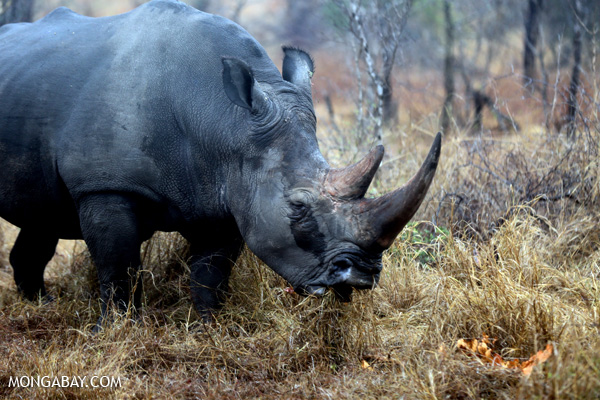 WARNING: graphic image below. White rhino in South Africa. Photo by: Rhett A. Butler. South Africa has surpassed last year’s grisly record for slaughtered rhinos—1,004—more than a month before the year ends. In an announcement on November 20th, the South African Department of Environmental Affairs said that 1,020 rhinos had been killed to date. Rhinos […]
WARNING: graphic image below. White rhino in South Africa. Photo by: Rhett A. Butler. South Africa has surpassed last year’s grisly record for slaughtered rhinos—1,004—more than a month before the year ends. In an announcement on November 20th, the South African Department of Environmental Affairs said that 1,020 rhinos had been killed to date. Rhinos […]
Tiger traffickers busted in Indonesia
 Confiscated tiger parts and suspects. Photo by the WCS Wildlife Crimes Unit. Two online merchants of tiger parts have been arrested in Indonesia. The bust was the result of a coordinated effort between local and national authorities, and the Wildlife Conservation Society (WCS) which supports ‘Wildlife Crimes Units’ operating throughout the country. The arrests are […]
Confiscated tiger parts and suspects. Photo by the WCS Wildlife Crimes Unit. Two online merchants of tiger parts have been arrested in Indonesia. The bust was the result of a coordinated effort between local and national authorities, and the Wildlife Conservation Society (WCS) which supports ‘Wildlife Crimes Units’ operating throughout the country. The arrests are […]
Officials bust one of the biggest players in illegal Indonesian manta ray trade
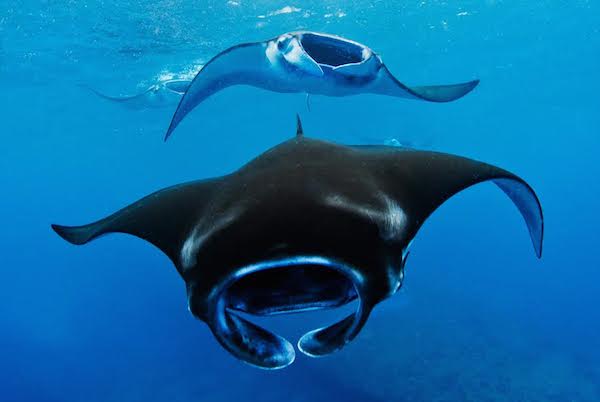 Exports of now-black market industry net $30M per year Writing this from a hotel room in Indonesia’s second-largest city, Surabaya, I realize that I am filled with trepidation as I wait for the phone next to me to ring. When it does, the voice on the other end will tell me it’s go time; the […]
Exports of now-black market industry net $30M per year Writing this from a hotel room in Indonesia’s second-largest city, Surabaya, I realize that I am filled with trepidation as I wait for the phone next to me to ring. When it does, the voice on the other end will tell me it’s go time; the […]
Indonesian authorities bust porcupine-smuggling ring
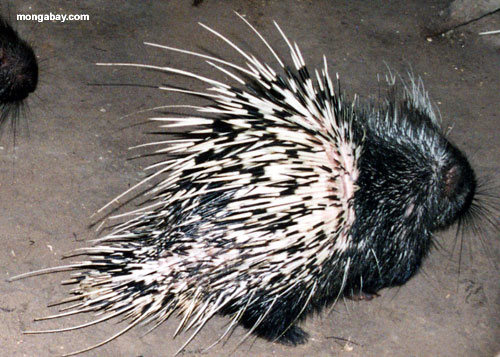 Police in Langkat, North Sumatra, Indonesia, seized 55 porcupines from smugglers preparing to ship the animals to China. Three suspects were detained during last week’s operation, while their accomplices remain at large. Dozens more animals reportedly obtained from dealers in Medan are still unaccounted for. Police Chief, Yulmar Tri Himawan, said the operation was part […]
Police in Langkat, North Sumatra, Indonesia, seized 55 porcupines from smugglers preparing to ship the animals to China. Three suspects were detained during last week’s operation, while their accomplices remain at large. Dozens more animals reportedly obtained from dealers in Medan are still unaccounted for. Police Chief, Yulmar Tri Himawan, said the operation was part […]
The threat of traditional medicine: China’s boom may mean doom for turtles
 Growing population and traditional mindset fueling demand for wild turtles, driving some species towards extinction For thousands of years turtles have been used in Chinese traditional medicine to treat a wide variety of ailments and diseases. Originally published in the journal Radiata and recently republished HerpDigest David S. Lee and Liao Shi Kun write, “[In […]
Growing population and traditional mindset fueling demand for wild turtles, driving some species towards extinction For thousands of years turtles have been used in Chinese traditional medicine to treat a wide variety of ailments and diseases. Originally published in the journal Radiata and recently republished HerpDigest David S. Lee and Liao Shi Kun write, “[In […]
Rhino with bullet in its brain and hacked off horn wanders for days before being put down
 WARNING: graphic image below. Last week, visitors in Kruger National Park came on a horrifying sight of the poaching trade: a rhino, still alive, with its horn and part of its face chopped off. The gruesome photo of the young rhino went viral and sent South African authorities scrambling. Five days after the sighting, South […]
WARNING: graphic image below. Last week, visitors in Kruger National Park came on a horrifying sight of the poaching trade: a rhino, still alive, with its horn and part of its face chopped off. The gruesome photo of the young rhino went viral and sent South African authorities scrambling. Five days after the sighting, South […]
South Africa loses nearly 150 rhinos to poachers so far this year
 Since the first of the year, South Africa has lost 146 rhinos to poachers or approximately 2.5 rhinos every day. This is a slight dip from last year’s poaching rate, which hit 1,004 for the whole year or 2.75 a day. South Africa is home to more rhinos than any other country on the planet, […]
Since the first of the year, South Africa has lost 146 rhinos to poachers or approximately 2.5 rhinos every day. This is a slight dip from last year’s poaching rate, which hit 1,004 for the whole year or 2.75 a day. South Africa is home to more rhinos than any other country on the planet, […]
Over 1,000 rhinos killed by poachers in South Africa last year
 In another sign that Africa’s poaching crisis has gotten completely out of control, South Africa lost 1,004 rhinos to poachers last year. According to the numbers released today by the South African Department of Environmental Affairs, 2013 was the worst year yet for rhino poaching in the country with nearly 3 rhinos killed every day. […]
In another sign that Africa’s poaching crisis has gotten completely out of control, South Africa lost 1,004 rhinos to poachers last year. According to the numbers released today by the South African Department of Environmental Affairs, 2013 was the worst year yet for rhino poaching in the country with nearly 3 rhinos killed every day. […]
Consumer report uncovers why people buy rhino horn
 The rhinoceros is one of the largest and most iconic animals to roam the earth. However, poaching for their horn, erroneously believed to have medicinal value, has led the IUCN Red List to classify three of the world’s five species as Critically Endangered. But, a new consumer report by the wildlife trade monitoring network, TRAFFIC, […]
The rhinoceros is one of the largest and most iconic animals to roam the earth. However, poaching for their horn, erroneously believed to have medicinal value, has led the IUCN Red List to classify three of the world’s five species as Critically Endangered. But, a new consumer report by the wildlife trade monitoring network, TRAFFIC, […]
Unlikely success: how Zimbabwe has become a global leader in rhino conservation
 Raoul du Toit will be speaking at the Wildlife Conservation Network Expo in San Francisco on October 12th, 2013. With its collapsed economy, entrenched poverty, and political tremors, one would not expect that a country like Zimbabwe would have the capacity to safeguard its rhinos against determined and well-funded poachers, especially as just across the […]
Raoul du Toit will be speaking at the Wildlife Conservation Network Expo in San Francisco on October 12th, 2013. With its collapsed economy, entrenched poverty, and political tremors, one would not expect that a country like Zimbabwe would have the capacity to safeguard its rhinos against determined and well-funded poachers, especially as just across the […]
Six smugglers sentenced to jail time over pangolin trafficking in Malaysia
 Six men have been sentenced to a year in jail after being convicted of smuggling 150 pangolins in peninsular Malaysia, reports Annamiticus. The men were also given fines totaling over $100,000. Pangolins are small, scaly mammals that feed on termites much like South America’s anteaters. The animals are in demand for their scales, which are […]
Six men have been sentenced to a year in jail after being convicted of smuggling 150 pangolins in peninsular Malaysia, reports Annamiticus. The men were also given fines totaling over $100,000. Pangolins are small, scaly mammals that feed on termites much like South America’s anteaters. The animals are in demand for their scales, which are […]
Rhino slaughtered for its horn in city park
 In another sign that the rhino poaching crisis has gone out-of-control, Kenyan officials announced late last night that a pregnant rhino was poached in Nairobi National Park, which sits on the edge of Kenya’s capital. Home to lions, leopard, giraffes and hippos in addition to rhinos, the park is known for its views of iconic […]
In another sign that the rhino poaching crisis has gone out-of-control, Kenyan officials announced late last night that a pregnant rhino was poached in Nairobi National Park, which sits on the edge of Kenya’s capital. Home to lions, leopard, giraffes and hippos in addition to rhinos, the park is known for its views of iconic […]
Zoos call on governments to take urgent action against illegal wildlife trade (photos)
 Warning: some photos may be disturbing or graphic. In a single night in March, a band of heavily-armed, horse-riding poachers slaughtered 89 elephants in southern Chad, thirty of which were pregnant females. The carnage was the worst poaching incident of the year, but even this slaughter paled in comparison to the 650 elephants killed in […]
Warning: some photos may be disturbing or graphic. In a single night in March, a band of heavily-armed, horse-riding poachers slaughtered 89 elephants in southern Chad, thirty of which were pregnant females. The carnage was the worst poaching incident of the year, but even this slaughter paled in comparison to the 650 elephants killed in […]
First ever pangolin conference concludes all eight species in trouble
 Demand for scales, meat, and even fetuses of pangolins have pushed all eight species of this unique mammalian order—Pholidota—toward extinction, according to the world’s first ever pangolin conference with the International Union for Conservation of Nature – Species Survival Commission (IUCN-SSC) Pangolin Specialist Group. Meeting in Singapore earlier this month, 40 conservationists from 14 countries […]
Demand for scales, meat, and even fetuses of pangolins have pushed all eight species of this unique mammalian order—Pholidota—toward extinction, according to the world’s first ever pangolin conference with the International Union for Conservation of Nature – Species Survival Commission (IUCN-SSC) Pangolin Specialist Group. Meeting in Singapore earlier this month, 40 conservationists from 14 countries […]
Manta ray tourism worth 28 times more than killing them for Traditional Chinese Medicine
 A new study in the open access journal PLoS ONE estimates that manta rays are worth $140 million a year in tourism across 23 countries, significantly outweighing the worth of manta ray gill plates, which have become the newest craze in Traditional Chinese Medicine. “As an example in Indonesia, revenue to fishermen from manta gill […]
A new study in the open access journal PLoS ONE estimates that manta rays are worth $140 million a year in tourism across 23 countries, significantly outweighing the worth of manta ray gill plates, which have become the newest craze in Traditional Chinese Medicine. “As an example in Indonesia, revenue to fishermen from manta gill […]
Prince Charles: take the war to the poachers
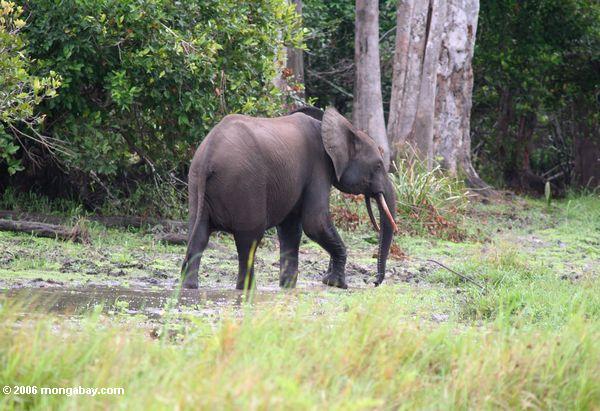 Prince Charles has warned that criminal gangs are turning to animal poaching, an unprecedented slaughter of species that can only be stopped by waging war on the perpetrators, in the latest of a series of increasingly outspoken speeches about the environment. Addressing a conference of conservationists at St James’s Palace in London, the Prince of […]
Prince Charles has warned that criminal gangs are turning to animal poaching, an unprecedented slaughter of species that can only be stopped by waging war on the perpetrators, in the latest of a series of increasingly outspoken speeches about the environment. Addressing a conference of conservationists at St James’s Palace in London, the Prince of […]
Rhino horn madness: over two rhinos killed a day in South Africa
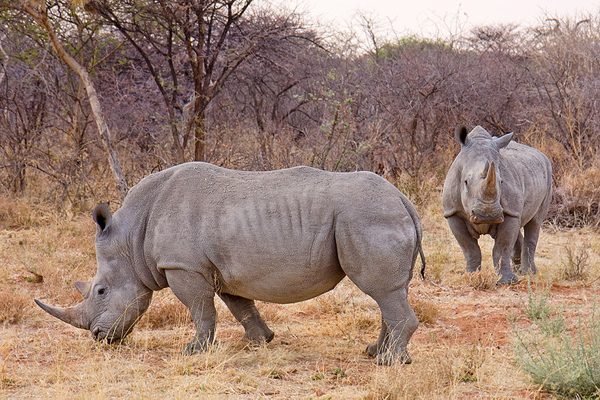 Rhino poachers have killed 232 rhinos during 2013 so far in South Africa, reports Annamiticus, which averages out to 2.1 a day. The country has become a flashpoint for rhino poaching as it holds more rhinos than any other country on Earth. Rhinos are being slaughter for their horns, which are believed to be a […]
Rhino poachers have killed 232 rhinos during 2013 so far in South Africa, reports Annamiticus, which averages out to 2.1 a day. The country has become a flashpoint for rhino poaching as it holds more rhinos than any other country on Earth. Rhinos are being slaughter for their horns, which are believed to be a […]
Lions for sale: big game hunting combines with lion bone trade to threaten endangered cats
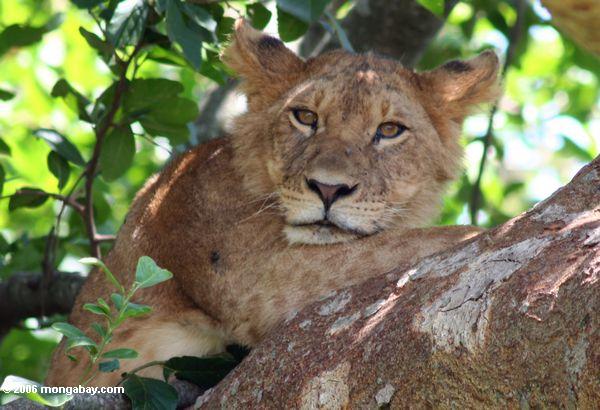 Koos Hermanus would rather not give names to the lions he breeds. So here, behind a 2.4-meter high electric fence, is 1R, a three-and-a-half-year-old male, who consumes 5kg of meat a day and weighs almost 200kg. It will only leave its enclosure once it has been “booked”‘ by a hunter, most of whom are from […]
Koos Hermanus would rather not give names to the lions he breeds. So here, behind a 2.4-meter high electric fence, is 1R, a three-and-a-half-year-old male, who consumes 5kg of meat a day and weighs almost 200kg. It will only leave its enclosure once it has been “booked”‘ by a hunter, most of whom are from […]
Double bad: Chinese vessel that collided with protected coral reef holding 22,000 pounds of pangolin meat
 What do you do when you’re smuggling 22,000 pounds of an endangered species on your boat? Answer: crash into a protected coral reef in the Philippines. Last Monday a Chinese vessel slammed into a coral reef in the Tubbataha National Marine Park; on Saturday the Filipino coastguard discovered 400 boxes of pangolin meat while inspecting […]
What do you do when you’re smuggling 22,000 pounds of an endangered species on your boat? Answer: crash into a protected coral reef in the Philippines. Last Monday a Chinese vessel slammed into a coral reef in the Tubbataha National Marine Park; on Saturday the Filipino coastguard discovered 400 boxes of pangolin meat while inspecting […]
Pity the pangolin: little-known mammal most common victim of the wildlife trade
 World Pangolin Day is celebrated this weekend: Saturday, February 16th, 2013 Last year tens-of-thousands of elephants and hundreds of rhinos were butchered to feed the growing appetite of the illegal wildlife trade. This black market, largely centered in East Asia, also devoured tigers, sharks, leopards, turtles, snakes, and hundreds of other animals. Estimated at $19 […]
World Pangolin Day is celebrated this weekend: Saturday, February 16th, 2013 Last year tens-of-thousands of elephants and hundreds of rhinos were butchered to feed the growing appetite of the illegal wildlife trade. This black market, largely centered in East Asia, also devoured tigers, sharks, leopards, turtles, snakes, and hundreds of other animals. Estimated at $19 […]
Asian bear farming: breaking the cycle of exploitation (warning: graphic images)
 Sun bear in a cage in Indonesia. Photo by: Chris R. Shepherd/TRAFFIC Southeast Asia. In the forests of Asia, bears are being captured. These captives will be sent to bear farms, most unregulated and illegal, where they will be kept alive in a small cage, locked away for life. Their bodies will be used as […]
Sun bear in a cage in Indonesia. Photo by: Chris R. Shepherd/TRAFFIC Southeast Asia. In the forests of Asia, bears are being captured. These captives will be sent to bear farms, most unregulated and illegal, where they will be kept alive in a small cage, locked away for life. Their bodies will be used as […]
Scary caterpillar fungus could lead to new cancer drug
 Caterpillars infected with Cordyceps sinensis, mostly whole. Photo by William Rafti of the William Rafti Institute. Cordyceps sinensis, commonly known as caterpillar fungus, may be a groundbreaking new treatment for a number of life-threatening conditions including asthma, kidney failure and cancer according to a paper recently published by The RNA Society. If you’re a caterpillar […]
Caterpillars infected with Cordyceps sinensis, mostly whole. Photo by William Rafti of the William Rafti Institute. Cordyceps sinensis, commonly known as caterpillar fungus, may be a groundbreaking new treatment for a number of life-threatening conditions including asthma, kidney failure and cancer according to a paper recently published by The RNA Society. If you’re a caterpillar […]
Leopard poaching is a bigger problem in India than previously believed
 Leopard skin. © TRAFFIC. A recent study conducted by wildlife trade monitoring group TRAFFIC uncovered unnerving statistics about the illegal trade of leopards (Panthera pardus) in India: at least four leopards have been poached every week for the past decade in the country. The study, entitled Illuminating the Blind Spot: A study on illegal trade […]
Leopard skin. © TRAFFIC. A recent study conducted by wildlife trade monitoring group TRAFFIC uncovered unnerving statistics about the illegal trade of leopards (Panthera pardus) in India: at least four leopards have been poached every week for the past decade in the country. The study, entitled Illuminating the Blind Spot: A study on illegal trade […]
South Africa hits another new record in rhino killings
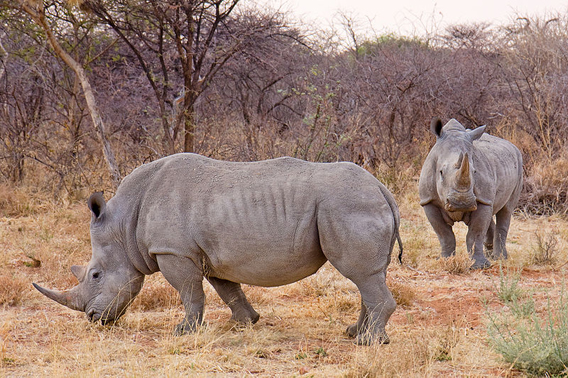 White rhinos in Namibia. White rhinos are the world’s most populous, but suffer massive poaching rates. Photo by: Ikiwaner. Four hundred and fifty-five rhinos have been killed by poachers in South Africa since the beginning of the year. The number surpasses the record set last year (448) and proves that national efforts to stem poaching […]
White rhinos in Namibia. White rhinos are the world’s most populous, but suffer massive poaching rates. Photo by: Ikiwaner. Four hundred and fifty-five rhinos have been killed by poachers in South Africa since the beginning of the year. The number surpasses the record set last year (448) and proves that national efforts to stem poaching […]
In midst of rhino poaching epidemic, Lewa Wildlife Conservancy has happy problem: too many black rhinos
 An interview with CEO of Lewa Wildlife Conservancy, Mike Watson. Black rhinoceros in Lewa Wildlife Conservancy (LWC). Photo courtesy of LWC. So far this year, South Africa has lost 430 rhinos to poachers, more than one animal a day. The epidemic of rhino poaching, fueled by demand for black-market powdered rhino horn in Vietnam and […]
An interview with CEO of Lewa Wildlife Conservancy, Mike Watson. Black rhinoceros in Lewa Wildlife Conservancy (LWC). Photo courtesy of LWC. So far this year, South Africa has lost 430 rhinos to poachers, more than one animal a day. The epidemic of rhino poaching, fueled by demand for black-market powdered rhino horn in Vietnam and […]
New website highlights the plight of the pangolin
GA_Sekkong-HKG_199305.568.jpg) The Chinese pangolin has recently been upgraded to Endangered on the IUCN Red List due to relentless poaching. Photo by: Gary Ades/KFBG. Scaly, insect-devouring, nocturnal, and notoriously shy, pangolins are strange mammals who remain unknown to many. But they are facing a major crisis as they are stolen from the wild in East Asia to […]
The Chinese pangolin has recently been upgraded to Endangered on the IUCN Red List due to relentless poaching. Photo by: Gary Ades/KFBG. Scaly, insect-devouring, nocturnal, and notoriously shy, pangolins are strange mammals who remain unknown to many. But they are facing a major crisis as they are stolen from the wild in East Asia to […]
Picture of the day: Yao Ming with baby elephant orphaned by ivory trade
 Yao Ming walks with Kinango, an infant elephant whose mother was killed by poachers at the David Sheldrick Wildlife Trust in Kenya. Photo by: Kristian Schmidt/WildAid. Former NBA Basketball player and Olympian, Yao Ming is taking his first trip through Africa in order to see the on-the-ground impacts of the black-market ivory and rhino trades […]
Yao Ming walks with Kinango, an infant elephant whose mother was killed by poachers at the David Sheldrick Wildlife Trust in Kenya. Photo by: Kristian Schmidt/WildAid. Former NBA Basketball player and Olympian, Yao Ming is taking his first trip through Africa in order to see the on-the-ground impacts of the black-market ivory and rhino trades […]
Pictures of the day: pangolins saved in Thailand from poachers
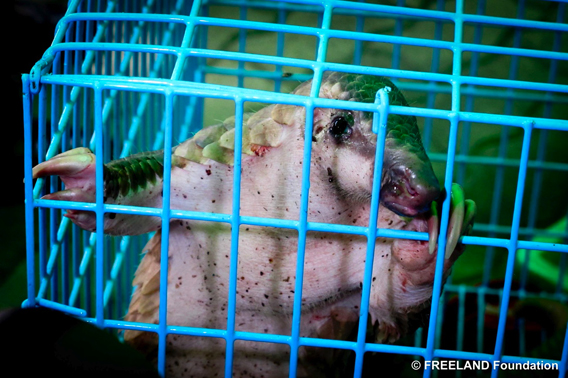 A rescued Sunda pangolin. Photo by: FREELAND Foundation. Earlier this summer, 110 Sunda pangolins (Manis javanica) were rescued by Thai customs officials from poachers in a pickup truck. While the driver of the vehicle escaped, a passenger was arrested, but released after paying a fine of $75,000, reports the NGO FREELAND Foundation. Pangolins are eaten […]
A rescued Sunda pangolin. Photo by: FREELAND Foundation. Earlier this summer, 110 Sunda pangolins (Manis javanica) were rescued by Thai customs officials from poachers in a pickup truck. While the driver of the vehicle escaped, a passenger was arrested, but released after paying a fine of $75,000, reports the NGO FREELAND Foundation. Pangolins are eaten […]
Hail Mary effort aims to save the world’s most endangered turtles
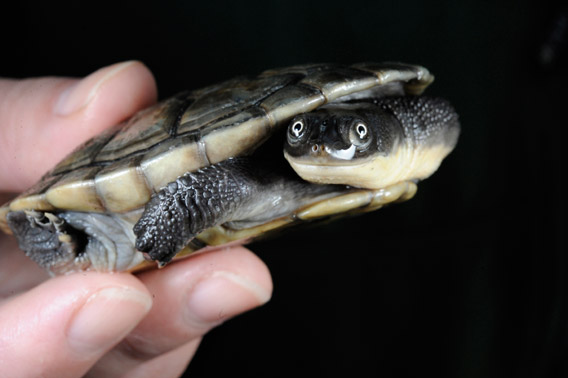 Roti snake island turtle, which is number 12 of the world’s most endangered turtles, are being captive bred at the WCS’s Bronx Zoo. Photo by: Julie Larsen Maher/WCS. The Wildlife Conservation Society (WCS) has pledged to work with all of its institutions to save at least half of the world’s most 25 endangered turtles as […]
Roti snake island turtle, which is number 12 of the world’s most endangered turtles, are being captive bred at the WCS’s Bronx Zoo. Photo by: Julie Larsen Maher/WCS. The Wildlife Conservation Society (WCS) has pledged to work with all of its institutions to save at least half of the world’s most 25 endangered turtles as […]
Kruger National Park loses 95 rhinos to poachers in three months
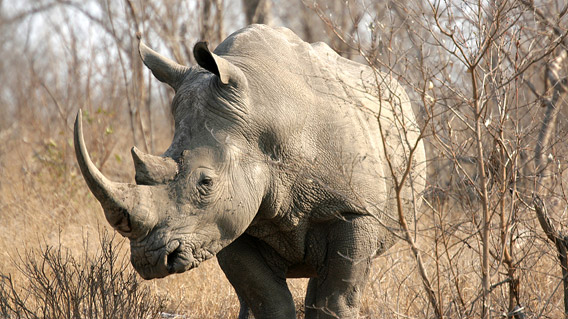 Rhinoceros, Kruger National Park, South Africa. A white rhinoceros (Ceratotherium simum) roaming Kruger, which is also home to the Critically Endangered black rhinoceros. Photo by: Bigstock. Since the first of the year, South Africa’s Kruger National Park has lost 95 rhinos to poachers, reports the blog Rhino Horn is NOT Medicine. South Africa, and Kruger […]
Rhinoceros, Kruger National Park, South Africa. A white rhinoceros (Ceratotherium simum) roaming Kruger, which is also home to the Critically Endangered black rhinoceros. Photo by: Bigstock. Since the first of the year, South Africa’s Kruger National Park has lost 95 rhinos to poachers, reports the blog Rhino Horn is NOT Medicine. South Africa, and Kruger […]
‘Where’s my mama?’: campaign targets cruel slow loris pet trade [warning: graphic photo]
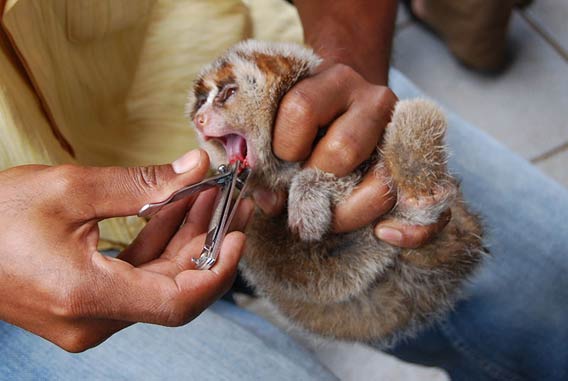 Slow lorises like this Sunda Slow Loris juvenile (Nycticebus coucang) have their teeth forcibly removed by animal traffickers in the open-air bird markets of Indonesia. The practice is done to either convince buyers that the animal is suitable as a child’s pet or to make people think the animal is an infant. This photo was […]
Slow lorises like this Sunda Slow Loris juvenile (Nycticebus coucang) have their teeth forcibly removed by animal traffickers in the open-air bird markets of Indonesia. The practice is done to either convince buyers that the animal is suitable as a child’s pet or to make people think the animal is an infant. This photo was […]
Majority of protected tropical forests “empty” due to hunting
 WARNING: Graphic photos below. Hunter in the Colombian rainforest. Photo by: Rhett A. Butler. Protected areas in the world’s tropical rainforests are absolutely essential, but one cannot simply set up a new refuge and believe the work is done, according to a new paper in Bioscience. Unsustainable hunting and poaching is decimating tropical forest species […]
WARNING: Graphic photos below. Hunter in the Colombian rainforest. Photo by: Rhett A. Butler. Protected areas in the world’s tropical rainforests are absolutely essential, but one cannot simply set up a new refuge and believe the work is done, according to a new paper in Bioscience. Unsustainable hunting and poaching is decimating tropical forest species […]
Sumatran rhino pregnant: conservationists hope third time’s the charm
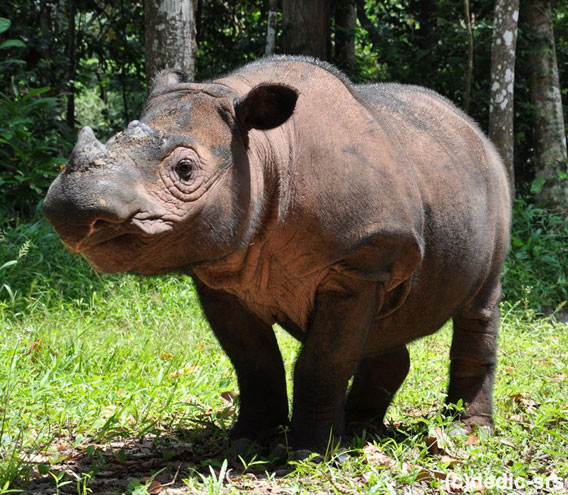 Conservationists hope Ratu, pictured above, has a successful third pregnancy. Photo by: International Rhino Foundation. Ratu, a female Sumatra rhino (Dicerorhinus sumatrensis), is in the eleventh month of her third pregnancy raising hopes for a successful birth of one of the world’s most imperiled big mammals. Ratu suffered two prior miscarriages, but researchers believe the […]
Conservationists hope Ratu, pictured above, has a successful third pregnancy. Photo by: International Rhino Foundation. Ratu, a female Sumatra rhino (Dicerorhinus sumatrensis), is in the eleventh month of her third pregnancy raising hopes for a successful birth of one of the world’s most imperiled big mammals. Ratu suffered two prior miscarriages, but researchers believe the […]
Vampire and bird frogs: discovering new amphibians in Southeast Asia’s threatened forests
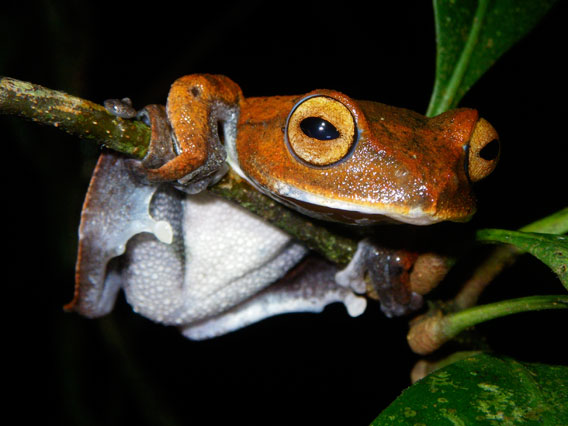 An interview with Jodi Rowley, a part of our on-going Interviews with Young Scientists series.
An interview with Jodi Rowley, a part of our on-going Interviews with Young Scientists series.
Pangolins imperiled by internet trade–are companies responding quickly enough?
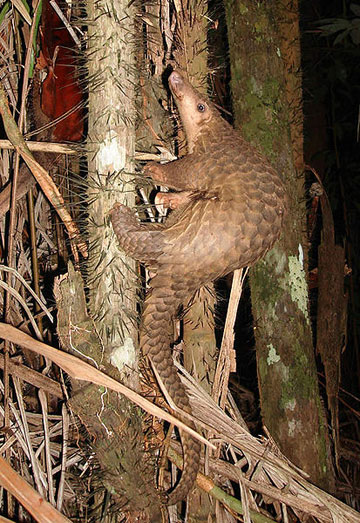 You can buy pretty much anything on the internet: from Rugby team garden gnomes to Mickey Mouse lingerie. In some places, consumers have even been able to purchase illegal wildlife parts, such as ivory and rhino horn. In fact, the internet has opened up the black market wildlife trade contributing to the destruction of biodiversity […]
You can buy pretty much anything on the internet: from Rugby team garden gnomes to Mickey Mouse lingerie. In some places, consumers have even been able to purchase illegal wildlife parts, such as ivory and rhino horn. In fact, the internet has opened up the black market wildlife trade contributing to the destruction of biodiversity […]
Happy rhino news: no rhinos poached in Nepal last year
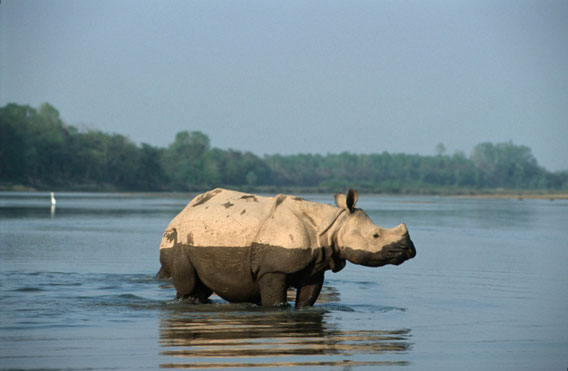 Greater one-horned rhino in Nepal. Photo courtesy of WWF. As rhinos again fell to poachers in record numbers in 2011, there was one bright-spot: Nepal. Not a single rhino was killed by poachers in the Himalayan nation, home to an estimated 534 greater one-horned rhinos (Rhinoceros unicornis), categorized as Vulnerable by the IUCN Red List. […]
Greater one-horned rhino in Nepal. Photo courtesy of WWF. As rhinos again fell to poachers in record numbers in 2011, there was one bright-spot: Nepal. Not a single rhino was killed by poachers in the Himalayan nation, home to an estimated 534 greater one-horned rhinos (Rhinoceros unicornis), categorized as Vulnerable by the IUCN Red List. […]
Top 10 Environmental Stories of 2011
 Victories won by activists around the world tops our list of the big environmental stories of the year. In this photo: a young woman is placed in handcuffs and arrested for civil disobedience against the Keystone XL Pipeline in the U.S. In all, 1,252 people were arrested in the two week long action. Photo by: […]
Victories won by activists around the world tops our list of the big environmental stories of the year. In this photo: a young woman is placed in handcuffs and arrested for civil disobedience against the Keystone XL Pipeline in the U.S. In all, 1,252 people were arrested in the two week long action. Photo by: […]
Photos: 208 species discovered in endangered Mekong region in 2010
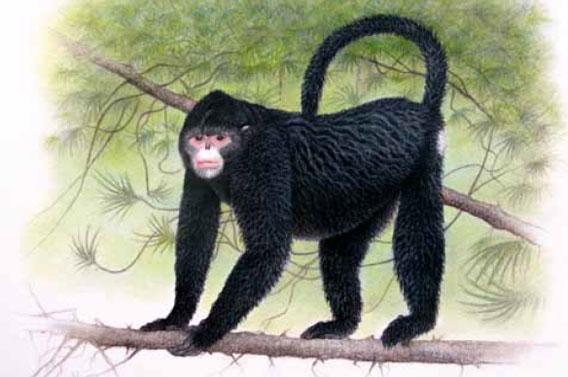 A new monkey, dubbed the Myanmar snub-nosed monkey (Rhinopithecus strykeri), was only discovered after researchers heard reports from hunters of a strange monkey with upturned nostrils and prominent lips in the remote Kachin region of Myanmar. It is known locally as mey nwoah, or ‘monkey with an upturned face’. Reportedly its easy to locate since […]
A new monkey, dubbed the Myanmar snub-nosed monkey (Rhinopithecus strykeri), was only discovered after researchers heard reports from hunters of a strange monkey with upturned nostrils and prominent lips in the remote Kachin region of Myanmar. It is known locally as mey nwoah, or ‘monkey with an upturned face’. Reportedly its easy to locate since […]
South Africa hits record poaching of rhinos—again
 WARNING: Graphic photo below. Indian rhino with its horn sawed off. A cut-off horn may help keep poachers away, but doesn’t guarantee it. Photo: Rhett A. Butler. Two months before the end of the year, the number of rhinos killed for their horns in South Africa has surpassed last year’s breaking record, reports conservation organizations […]
WARNING: Graphic photo below. Indian rhino with its horn sawed off. A cut-off horn may help keep poachers away, but doesn’t guarantee it. Photo: Rhett A. Butler. Two months before the end of the year, the number of rhinos killed for their horns in South Africa has surpassed last year’s breaking record, reports conservation organizations […]
Vietnamese rhino goes extinct
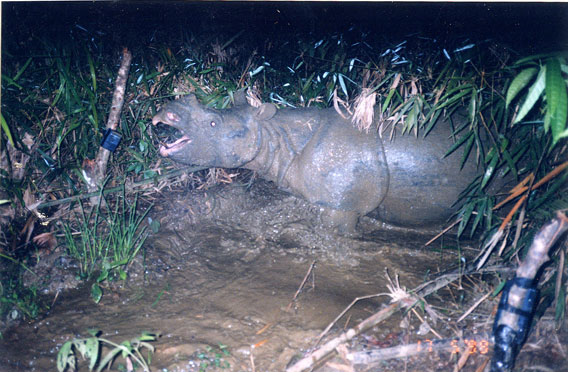 Camera trap catches one of the world’s last Vietnamese rhinos before its extinction. Photo courtesy of WWF. In 2009 poachers shot and killed the world’s last Vietnamese rhinoceros (Rhinoceros sondaicus annamiticus), a subspecies of the Javan rhino, confirms a report from International Rhino Foundation (IRF) and the World Wide Fund for Nature (WWF). The Vietnamese […]
Camera trap catches one of the world’s last Vietnamese rhinos before its extinction. Photo courtesy of WWF. In 2009 poachers shot and killed the world’s last Vietnamese rhinoceros (Rhinoceros sondaicus annamiticus), a subspecies of the Javan rhino, confirms a report from International Rhino Foundation (IRF) and the World Wide Fund for Nature (WWF). The Vietnamese […]
Cute animal picture of the day: ginger-haired baby monkey
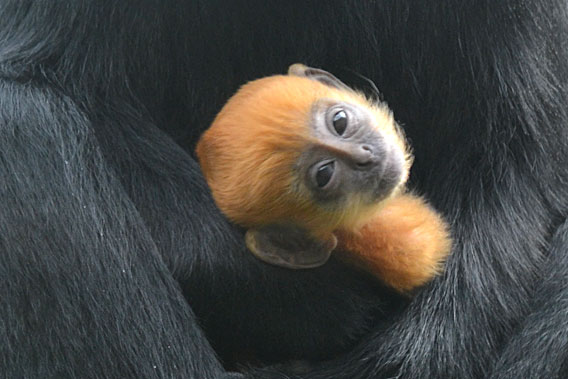 Baby Francois langur looking at the world at the London zoo. Photo courtesy of ZSL. One of the world’s most endangered primates recently gave birth to an orange-haired baby at the Zoological Society of London (ZSL) Zoo in London. It’s the mother Francois langur (Trachypithecus francoisi)’s first birth. The fire-orange hair of the baby is […]
Baby Francois langur looking at the world at the London zoo. Photo courtesy of ZSL. One of the world’s most endangered primates recently gave birth to an orange-haired baby at the Zoological Society of London (ZSL) Zoo in London. It’s the mother Francois langur (Trachypithecus francoisi)’s first birth. The fire-orange hair of the baby is […]
Eating rhino horn sends woman to hospital
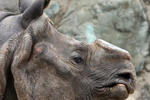 A Vietnamese woman ended up in the hospital after consuming rhino horn, reports savingrhinos.org. Used for a rash around her mouth, the rhino horn instead caused a serious allergic reaction, including reddening skin, itching, and fever. Listed under the Convention on International Trade in Endangered Species of Wild Fauna and Flora (CITES), rhino horn is […]
A Vietnamese woman ended up in the hospital after consuming rhino horn, reports savingrhinos.org. Used for a rash around her mouth, the rhino horn instead caused a serious allergic reaction, including reddening skin, itching, and fever. Listed under the Convention on International Trade in Endangered Species of Wild Fauna and Flora (CITES), rhino horn is […]
How do we save the Sumatran rhino?
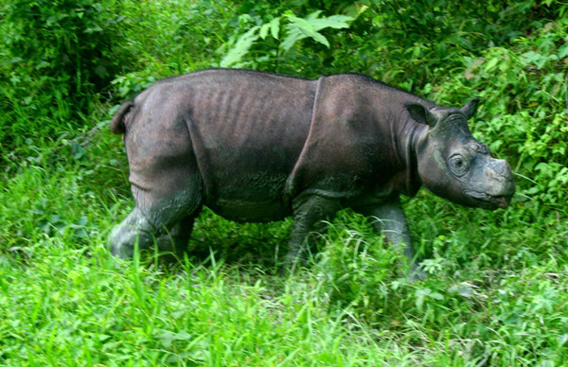 Tam, a male Sumatran rhino is kept in semi-captivity in Borneo with hopes to mate him with a female. The Sumatran rhinos on Borneo are actually a unique subspecies, dubbed the Borneo rhino, they are the world’s smallest.Photo by: Jeremy Hance. Some conservation challenges are more daunting than others. For example, how do you save […]
Tam, a male Sumatran rhino is kept in semi-captivity in Borneo with hopes to mate him with a female. The Sumatran rhinos on Borneo are actually a unique subspecies, dubbed the Borneo rhino, they are the world’s smallest.Photo by: Jeremy Hance. Some conservation challenges are more daunting than others. For example, how do you save […]
Bear bile trade, both legal and illegal, ubiquitous in Asia
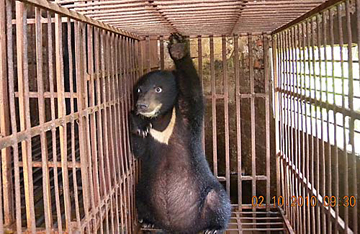 Surveying 13 nations and territories in Asia, the wildlife trade organization TRAFFIC found that the bear bile trade remains practically ubiquitous in the region. In many cases the trade, which extracts bile from captive bears’ gall bladders for sale as a pharmaceutical, flouts both local and international law, including Appendix I of Convention on International […]
Surveying 13 nations and territories in Asia, the wildlife trade organization TRAFFIC found that the bear bile trade remains practically ubiquitous in the region. In many cases the trade, which extracts bile from captive bears’ gall bladders for sale as a pharmaceutical, flouts both local and international law, including Appendix I of Convention on International […]
Cambodia’s wildlife pioneer: saving species and places in Southeast Asia’s last forest
- Suwanna Gauntlett has dedicated her life to protecting rainforests and wildlife in some of the world’s most hostile and rugged environments and has set the trend of a new generation of direct action conservationists.
- She has designed, implemented, and supported bold, front-line conservation programs to save endangered wildlife populations from the brink of extinction.
- When she first arrived in Cambodia in the late 1990s, its forests were silent.
Belief and butchery: how lies and organized crime are pushing rhinos to extinction
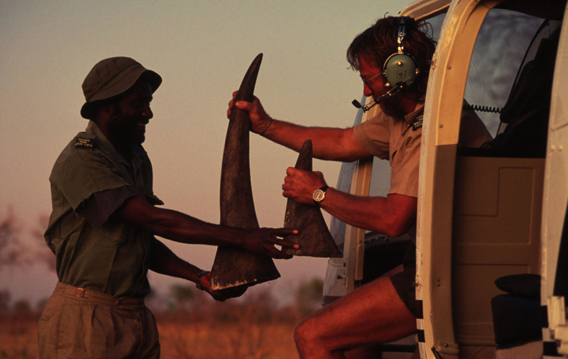 WARNING: Graphic photos below. Recently cut white rhino horns in Zimbabwe. Photos: © Michel Gunther / WWF-Canon. Few animals face as violent, as well organized, and as determined an enemy as the world’s rhinos. Across the globe rhinos are being slaughtered in record numbers; on average more than one rhino is killed by poachers everyday. […]
WARNING: Graphic photos below. Recently cut white rhino horns in Zimbabwe. Photos: © Michel Gunther / WWF-Canon. Few animals face as violent, as well organized, and as determined an enemy as the world’s rhinos. Across the globe rhinos are being slaughtered in record numbers; on average more than one rhino is killed by poachers everyday. […]
New eco-tour to help save bizarre antelope in ‘forgotten’ region
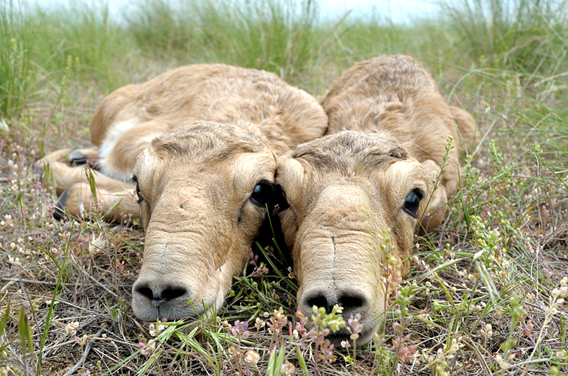 Saiga calves. Photo by: Igor Shpilenok. Imagine visiting a region that is largely void of tourists, yet has world-class bird watching, a unique Buddhist population, and one of the world’s most bizarre-looking and imperilled mammals: the saiga. A new tour to Southern Russia hopes to aid a Critically Endangered species while giving tourists an inside […]
Saiga calves. Photo by: Igor Shpilenok. Imagine visiting a region that is largely void of tourists, yet has world-class bird watching, a unique Buddhist population, and one of the world’s most bizarre-looking and imperilled mammals: the saiga. A new tour to Southern Russia hopes to aid a Critically Endangered species while giving tourists an inside […]
In spite of poaching, Nepal’s rhino population on the rise
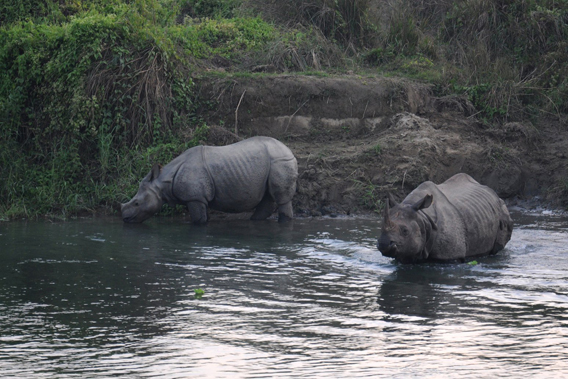 One-horned rhinos, or Indian rhinos, in Nepal’s Chitwan National Park. Photo by: Praveen Sharma/www.prveen.com . Good news for rhinos is rare recently, but a new census shows that Nepal’s one-horned rhino (Rhinoceros unicornis) population has increased by 23% since 2008 even in the face of poaching. In total 534 rhinos survive in Nepal, a rise […]
One-horned rhinos, or Indian rhinos, in Nepal’s Chitwan National Park. Photo by: Praveen Sharma/www.prveen.com . Good news for rhinos is rare recently, but a new census shows that Nepal’s one-horned rhino (Rhinoceros unicornis) population has increased by 23% since 2008 even in the face of poaching. In total 534 rhinos survive in Nepal, a rise […]
Pet trade, palm oil, and poaching: the challenges of saving the ‘forgotten bear’
 This interview is an excerpt from The WildLife with Laurel Neme, a program that explores the mysteries of the animal world through interviews with scientists and other wildlife investigators. “The WildLife” airs every Monday from 1-2 pm EST on WOMM-LP, 105.9 FM in Burlington, Vermont. You can livestream it at theradiator.org or download the podcast […]
This interview is an excerpt from The WildLife with Laurel Neme, a program that explores the mysteries of the animal world through interviews with scientists and other wildlife investigators. “The WildLife” airs every Monday from 1-2 pm EST on WOMM-LP, 105.9 FM in Burlington, Vermont. You can livestream it at theradiator.org or download the podcast […]
Video: camera trap proves world’s rarest rhino is breeding
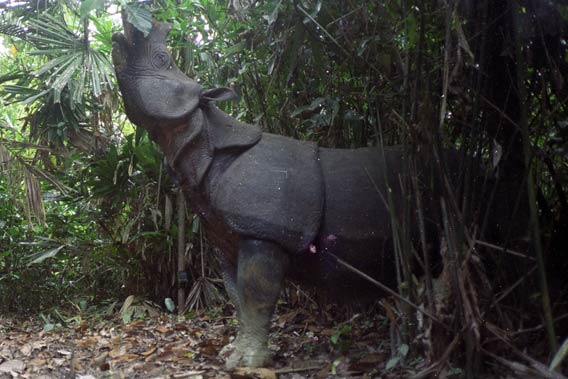 A Javan rhino (Rhinoceros sondaicus) captured on a camera trap browses for food. Javan rhinos are herbivores and eat around 110 lbs of food daily. Photo courtesy of WWF. There may only be 40 left in the world, but intimate footage of Javan rhino mothers and calves have been captured by video-camera trap in Ujung […]
A Javan rhino (Rhinoceros sondaicus) captured on a camera trap browses for food. Javan rhinos are herbivores and eat around 110 lbs of food daily. Photo courtesy of WWF. There may only be 40 left in the world, but intimate footage of Javan rhino mothers and calves have been captured by video-camera trap in Ujung […]
California proposes ban on selling shark fin
 Last year Hawaii banned the sale of shark fins; California may be next. Bill 376, introduced by two Democrats, would outlaw the sale of shark fins, including the popular Asian delicacy shark fin soup, in the US’s most populous state. One of the bill’s sponsors, Paul Fong, said at a new conference as reported by […]
Last year Hawaii banned the sale of shark fins; California may be next. Bill 376, introduced by two Democrats, would outlaw the sale of shark fins, including the popular Asian delicacy shark fin soup, in the US’s most populous state. One of the bill’s sponsors, Paul Fong, said at a new conference as reported by […]
A lion’s story, an interview with the filmmakers of The Last Lions
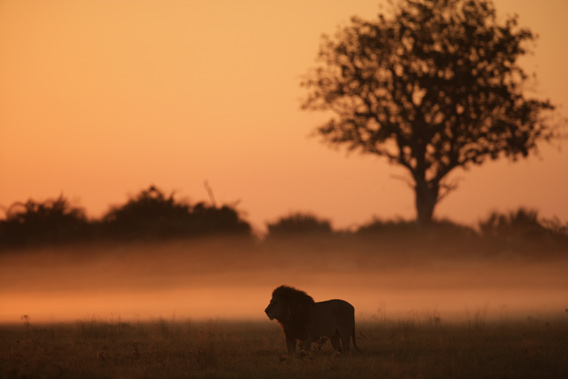 Male lion in the Okavango Delta. © National Geographic Entertainment. Photo by: Beverly Joubert . The new theatrical film, The Last Lions does not open, as one would expect, with a shot of lions or even an African panorama. Instead the first shot is a view of our planet from space at night. Billions of […]
Male lion in the Okavango Delta. © National Geographic Entertainment. Photo by: Beverly Joubert . The new theatrical film, The Last Lions does not open, as one would expect, with a shot of lions or even an African panorama. Instead the first shot is a view of our planet from space at night. Billions of […]
Rhino horn price matches cocaine
 As a rhino poaching epidemic continues throughout Africa and Asia, the price of rhino horn has matched cocaine, according to the UK’s Daily Mirror. The price of illegal powdered rhino horn—obtained by killing wild rhinos and sawing off their horns—has hit £31,000 per kilo or nearly $50,000 per kilo. The price has already topped that […]
As a rhino poaching epidemic continues throughout Africa and Asia, the price of rhino horn has matched cocaine, according to the UK’s Daily Mirror. The price of illegal powdered rhino horn—obtained by killing wild rhinos and sawing off their horns—has hit £31,000 per kilo or nearly $50,000 per kilo. The price has already topped that […]
Tiger summit reaches bold agreement and raises $300 million
 The summit to save the world’s biggest cat, and one of the world’s most popular animals, has agreed to a bold plan dubbed the Global Tiger Recovery Program. Meeting in St. Petersburg, 13 nations have set a goal to double the wild tiger’s (Panthera tigris) population worldwide by 2022. Given that tiger numbers continue to […]
The summit to save the world’s biggest cat, and one of the world’s most popular animals, has agreed to a bold plan dubbed the Global Tiger Recovery Program. Meeting in St. Petersburg, 13 nations have set a goal to double the wild tiger’s (Panthera tigris) population worldwide by 2022. Given that tiger numbers continue to […]
Alleged rhino horn dealer takes his own life
 The illegal trade in rhino horn doesn’t just end in the deaths of thousands of rhinos. Humans, too, often lose their lives in the trade. Both those poaching rhinos and those protecting them, such as park rangers, have been killed in gun battles. But the trade ruins lives in many ways: yesterday, Tommy Fourie, 51, […]
The illegal trade in rhino horn doesn’t just end in the deaths of thousands of rhinos. Humans, too, often lose their lives in the trade. Both those poaching rhinos and those protecting them, such as park rangers, have been killed in gun battles. But the trade ruins lives in many ways: yesterday, Tommy Fourie, 51, […]
Authorities confiscated over 1000 tigers in past decade
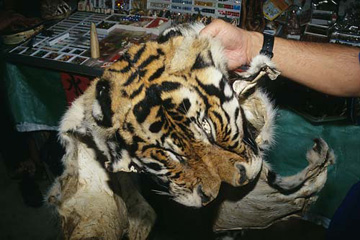 Highlighting the poaching crisis facing tigers, a new report by the wildlife trade organization, TRAFFIC, found that from 2000-2010 authorities have confiscated the parts of 1,069 tiger individuals, many of them dead. The tigers, or their body parts, were confiscated from 11 of the species’ 13 range countries, according to the report entitled Reduced to […]
Highlighting the poaching crisis facing tigers, a new report by the wildlife trade organization, TRAFFIC, found that from 2000-2010 authorities have confiscated the parts of 1,069 tiger individuals, many of them dead. The tigers, or their body parts, were confiscated from 11 of the species’ 13 range countries, according to the report entitled Reduced to […]
Undercover for animals: on the frontline of wildlife crime in the US
 US Fish and Wildlife Service Special Agent Sheila O’Connor revealed the inside story of working in wildlife law enforcement to Laurel Neme on her “The WildLife” radio show and podcast. In the first of a two-part interview, Special Agent O’Connor talks about her adventures stopping wildlife crime—scoping out pet shops in the Chicago area for […]
US Fish and Wildlife Service Special Agent Sheila O’Connor revealed the inside story of working in wildlife law enforcement to Laurel Neme on her “The WildLife” radio show and podcast. In the first of a two-part interview, Special Agent O’Connor talks about her adventures stopping wildlife crime—scoping out pet shops in the Chicago area for […]
Over 20,000 pangolins illegally poached in Borneo
 Notebooks confiscated by the Sabah Wildlife Department (SWD) reveal that 22,000 Sunda pangolins (Manis javanica) were illegally poached from May 2007 to January 2009 in the Malaysian state in northern Borneo. The number, in fact, may be significantly higher since the logbooks didn’t cover over a third of the time period. The logbooks were analyzed […]
Notebooks confiscated by the Sabah Wildlife Department (SWD) reveal that 22,000 Sunda pangolins (Manis javanica) were illegally poached from May 2007 to January 2009 in the Malaysian state in northern Borneo. The number, in fact, may be significantly higher since the logbooks didn’t cover over a third of the time period. The logbooks were analyzed […]
Video: camera trap catches bulldozer clearing Sumatran tiger habitat for palm oil
 Seven days after footage of a Sumatran tiger (Panthera tigris sumatrae) was taken by a heat-trigger video camera trap, the camera captured a bulldozer clearing the Critically Endangered animal’s habitat. Taken by the World Wildlife Fund—Indonesia (WWF), the video provides clear evidence of forest destruction for oil palm plantations in Bukit Batabuh Protected Forest, a […]
Seven days after footage of a Sumatran tiger (Panthera tigris sumatrae) was taken by a heat-trigger video camera trap, the camera captured a bulldozer clearing the Critically Endangered animal’s habitat. Taken by the World Wildlife Fund—Indonesia (WWF), the video provides clear evidence of forest destruction for oil palm plantations in Bukit Batabuh Protected Forest, a […]
Chinese court sentences rhino horn smuggler to 12 years
 A traditional Chinese medicine businessman has been sentenced to 12 years in prison for attempting to smuggler rhino horn from Vietnam to China, according to Saving Rhinos which has been following the case on ChinaCourt.org. Last December, the Chinese suspect was arrested in Vietnam with two rhino horns worth over 100,000 US dollars. The suspect […]
A traditional Chinese medicine businessman has been sentenced to 12 years in prison for attempting to smuggler rhino horn from Vietnam to China, according to Saving Rhinos which has been following the case on ChinaCourt.org. Last December, the Chinese suspect was arrested in Vietnam with two rhino horns worth over 100,000 US dollars. The suspect […]
Already illegal, one man tests poisoning rhino horn too
Given the epidemic of rhino poaching across Africa and Asia, which has placed four out of five species in jeopardy of extinction, one fed-up game manager wants to take the fight beyond the poachers to the consumer. Ed Hern, owner of the Lion and Rhino Park near Johannesburg, told South Africa’s The Times that he […]
Cina Sita Sekitar 2.000 Trenggiling yang Diperdagangkan Ilegal
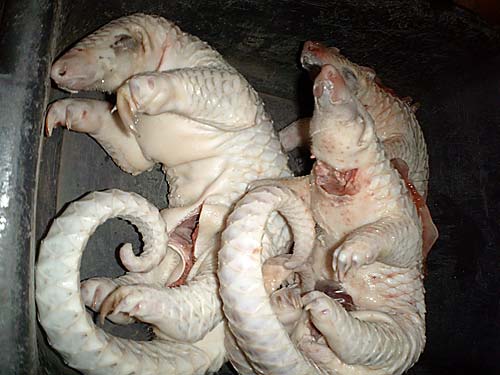 Memasuki sebuah kapal pengangkut parang pagi-pagi di tanggal 6 Juni, pegawai bea cukai menemukan 2.090 trenggiling beku dan 92 bungkus sisik trenggiling, seberat 3.960 pound. Dijalankan oleh lima orang Cina dan satu Malaysia, kapal tersebut sedang menunggu instruksi melalui telepon satelit untuk bertemu dengan kapal lain untuk transfer kargo ilegal saat masih di laut. “Penggunaan […]
Memasuki sebuah kapal pengangkut parang pagi-pagi di tanggal 6 Juni, pegawai bea cukai menemukan 2.090 trenggiling beku dan 92 bungkus sisik trenggiling, seberat 3.960 pound. Dijalankan oleh lima orang Cina dan satu Malaysia, kapal tersebut sedang menunggu instruksi melalui telepon satelit untuk bertemu dengan kapal lain untuk transfer kargo ilegal saat masih di laut. “Penggunaan […]
China seizes over 2,000 illegally trafficked pangolins
 Boarding a suspect fishing vessel in the early morning of June 6th, Chinese customs officials discovered 2,090 frozen pangolins and 92 cases of pangolin scales, weighing an astounding 3,960 pounds. Manned by five Chinese and one Malaysian national, the boat was awaiting instructions via satellite phone as to where to meet another ship to transfer […]
Boarding a suspect fishing vessel in the early morning of June 6th, Chinese customs officials discovered 2,090 frozen pangolins and 92 cases of pangolin scales, weighing an astounding 3,960 pounds. Manned by five Chinese and one Malaysian national, the boat was awaiting instructions via satellite phone as to where to meet another ship to transfer […]
Elle MacPherson mempromosikan penggunaan cula badak ilegal [Peringatan: Gambar Grafis]
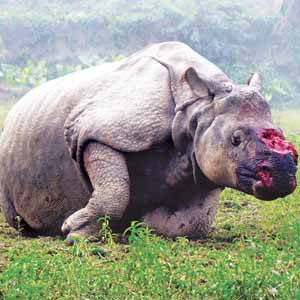 Walaupun sejumlah penelitian ilmiah menunjukkan bahwa cula badak tidak bersifat menyembuhkan, supermodel, pengusaha, dan saat ini adalah pembawa acara Britain’s Next Top Model, Elle MacPherson, berkata bahwa dia mengonsumsi bubuk cula badak sebab: “[ini] mujarab bagi saya”. Dalam sebuah wawancara dengan The Times Online via Twitter, Elle MacPherson berkata bahwa bahan ilegal ini rasanya seperti […]
Walaupun sejumlah penelitian ilmiah menunjukkan bahwa cula badak tidak bersifat menyembuhkan, supermodel, pengusaha, dan saat ini adalah pembawa acara Britain’s Next Top Model, Elle MacPherson, berkata bahwa dia mengonsumsi bubuk cula badak sebab: “[ini] mujarab bagi saya”. Dalam sebuah wawancara dengan The Times Online via Twitter, Elle MacPherson berkata bahwa bahan ilegal ini rasanya seperti […]
Elle MacPherson promotes consumption of illegal rhino horn [warning: graphic image]
 Despite a number of scientific studies showing that rhino horn has no curative properties, supermodel, entrepreneur, and recent host of Britain’s Next Top Model, Elle Macpherson, says she ingests powdered rhino horn because: “[it] works for me”. In an interview with The Times Online via Twitter, Elle Macpherson says the illegal substance tastes like “crushed […]
Despite a number of scientific studies showing that rhino horn has no curative properties, supermodel, entrepreneur, and recent host of Britain’s Next Top Model, Elle Macpherson, says she ingests powdered rhino horn because: “[it] works for me”. In an interview with The Times Online via Twitter, Elle Macpherson says the illegal substance tastes like “crushed […]
National parks in India and Nepal hit by rhino poachers
The rare Indian rhinoceros is not safe from poachers even in national parks. In Nepal’s world renowned Royal Chitwan National Park, twenty-four Indian rhinos (Rhinoceros unicornis) have been poached since the last census was taken in 2008. The most recent one was killed last Thursday. Approximately 372 Indian rhinos survive in the park, and the […]
India to track every tiger death on-line
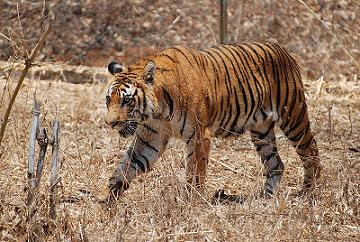 Due to increased problems with poaching, the conservation organization TRAFFIC has joined with the National Tiger Conservation Authority (NTCA) to begin tracking every tiger mortality in India with a new website called Tigernet. The website will also track tiger-related crimes, allowing wildlife wardens and field directors of Project Tiger Reserves to access key data on […]
Due to increased problems with poaching, the conservation organization TRAFFIC has joined with the National Tiger Conservation Authority (NTCA) to begin tracking every tiger mortality in India with a new website called Tigernet. The website will also track tiger-related crimes, allowing wildlife wardens and field directors of Project Tiger Reserves to access key data on […]
Video: rare footage of the sun bear, the world’s smallest, making a nest in the canopy
 Sun bear expert, Siew Te Wong, has captured rare footage of the world’s smallest bear making a nest high in the canopy. The nest-building of a sun bear is behaviour rarely seen, let alone filmed. The sun bear in the video is a radio-collared individual that Wong is keeping tabs on in Borneo. “Sun bears […]
Sun bear expert, Siew Te Wong, has captured rare footage of the world’s smallest bear making a nest high in the canopy. The nest-building of a sun bear is behaviour rarely seen, let alone filmed. The sun bear in the video is a radio-collared individual that Wong is keeping tabs on in Borneo. “Sun bears […]
Box turtles in Asia imperiled by massive trade
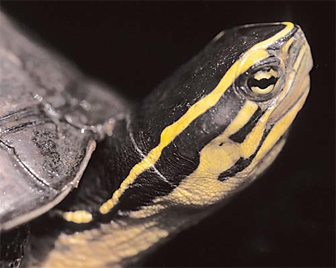 Massive international trade in Southeast Asian Box Turtles (Cuora amboinensis) has driven the species to near-extinction in parts of Indonesia, according to a new report by TRAFFIC, the wildlife trade monitoring network. The species, which is listed on the IUCN Red List as Vulnerable to extinction due to depletion and its low reproductive rate, is […]
Massive international trade in Southeast Asian Box Turtles (Cuora amboinensis) has driven the species to near-extinction in parts of Indonesia, according to a new report by TRAFFIC, the wildlife trade monitoring network. The species, which is listed on the IUCN Red List as Vulnerable to extinction due to depletion and its low reproductive rate, is […]
Feeds: news | india | latam | brasil | indonesia
 WARNING: graphic image below. White rhino in South Africa. Photo by: Rhett A. Butler. South Africa has surpassed last year’s grisly record for slaughtered rhinos—1,004—more than a month before the year ends. In an announcement on November 20th, the South African Department of Environmental Affairs said that 1,020 rhinos had been killed to date. Rhinos […]
WARNING: graphic image below. White rhino in South Africa. Photo by: Rhett A. Butler. South Africa has surpassed last year’s grisly record for slaughtered rhinos—1,004—more than a month before the year ends. In an announcement on November 20th, the South African Department of Environmental Affairs said that 1,020 rhinos had been killed to date. Rhinos […] Confiscated tiger parts and suspects. Photo by the WCS Wildlife Crimes Unit. Two online merchants of tiger parts have been arrested in Indonesia. The bust was the result of a coordinated effort between local and national authorities, and the Wildlife Conservation Society (WCS) which supports ‘Wildlife Crimes Units’ operating throughout the country. The arrests are […]
Confiscated tiger parts and suspects. Photo by the WCS Wildlife Crimes Unit. Two online merchants of tiger parts have been arrested in Indonesia. The bust was the result of a coordinated effort between local and national authorities, and the Wildlife Conservation Society (WCS) which supports ‘Wildlife Crimes Units’ operating throughout the country. The arrests are […] Exports of now-black market industry net $30M per year Writing this from a hotel room in Indonesia’s second-largest city, Surabaya, I realize that I am filled with trepidation as I wait for the phone next to me to ring. When it does, the voice on the other end will tell me it’s go time; the […]
Exports of now-black market industry net $30M per year Writing this from a hotel room in Indonesia’s second-largest city, Surabaya, I realize that I am filled with trepidation as I wait for the phone next to me to ring. When it does, the voice on the other end will tell me it’s go time; the […] Police in Langkat, North Sumatra, Indonesia, seized 55 porcupines from smugglers preparing to ship the animals to China. Three suspects were detained during last week’s operation, while their accomplices remain at large. Dozens more animals reportedly obtained from dealers in Medan are still unaccounted for. Police Chief, Yulmar Tri Himawan, said the operation was part […]
Police in Langkat, North Sumatra, Indonesia, seized 55 porcupines from smugglers preparing to ship the animals to China. Three suspects were detained during last week’s operation, while their accomplices remain at large. Dozens more animals reportedly obtained from dealers in Medan are still unaccounted for. Police Chief, Yulmar Tri Himawan, said the operation was part […] Growing population and traditional mindset fueling demand for wild turtles, driving some species towards extinction For thousands of years turtles have been used in Chinese traditional medicine to treat a wide variety of ailments and diseases. Originally published in the journal Radiata and recently republished HerpDigest David S. Lee and Liao Shi Kun write, “[In […]
Growing population and traditional mindset fueling demand for wild turtles, driving some species towards extinction For thousands of years turtles have been used in Chinese traditional medicine to treat a wide variety of ailments and diseases. Originally published in the journal Radiata and recently republished HerpDigest David S. Lee and Liao Shi Kun write, “[In […] WARNING: graphic image below. Last week, visitors in Kruger National Park came on a horrifying sight of the poaching trade: a rhino, still alive, with its horn and part of its face chopped off. The gruesome photo of the young rhino went viral and sent South African authorities scrambling. Five days after the sighting, South […]
WARNING: graphic image below. Last week, visitors in Kruger National Park came on a horrifying sight of the poaching trade: a rhino, still alive, with its horn and part of its face chopped off. The gruesome photo of the young rhino went viral and sent South African authorities scrambling. Five days after the sighting, South […] Since the first of the year, South Africa has lost 146 rhinos to poachers or approximately 2.5 rhinos every day. This is a slight dip from last year’s poaching rate, which hit 1,004 for the whole year or 2.75 a day. South Africa is home to more rhinos than any other country on the planet, […]
Since the first of the year, South Africa has lost 146 rhinos to poachers or approximately 2.5 rhinos every day. This is a slight dip from last year’s poaching rate, which hit 1,004 for the whole year or 2.75 a day. South Africa is home to more rhinos than any other country on the planet, […] In another sign that Africa’s poaching crisis has gotten completely out of control, South Africa lost 1,004 rhinos to poachers last year. According to the numbers released today by the South African Department of Environmental Affairs, 2013 was the worst year yet for rhino poaching in the country with nearly 3 rhinos killed every day. […]
In another sign that Africa’s poaching crisis has gotten completely out of control, South Africa lost 1,004 rhinos to poachers last year. According to the numbers released today by the South African Department of Environmental Affairs, 2013 was the worst year yet for rhino poaching in the country with nearly 3 rhinos killed every day. […] Six men have been sentenced to a year in jail after being convicted of smuggling 150 pangolins in peninsular Malaysia, reports Annamiticus. The men were also given fines totaling over $100,000. Pangolins are small, scaly mammals that feed on termites much like South America’s anteaters. The animals are in demand for their scales, which are […]
Six men have been sentenced to a year in jail after being convicted of smuggling 150 pangolins in peninsular Malaysia, reports Annamiticus. The men were also given fines totaling over $100,000. Pangolins are small, scaly mammals that feed on termites much like South America’s anteaters. The animals are in demand for their scales, which are […] In another sign that the rhino poaching crisis has gone out-of-control, Kenyan officials announced late last night that a pregnant rhino was poached in Nairobi National Park, which sits on the edge of Kenya’s capital. Home to lions, leopard, giraffes and hippos in addition to rhinos, the park is known for its views of iconic […]
In another sign that the rhino poaching crisis has gone out-of-control, Kenyan officials announced late last night that a pregnant rhino was poached in Nairobi National Park, which sits on the edge of Kenya’s capital. Home to lions, leopard, giraffes and hippos in addition to rhinos, the park is known for its views of iconic […] Warning: some photos may be disturbing or graphic. In a single night in March, a band of heavily-armed, horse-riding poachers slaughtered 89 elephants in southern Chad, thirty of which were pregnant females. The carnage was the worst poaching incident of the year, but even this slaughter paled in comparison to the 650 elephants killed in […]
Warning: some photos may be disturbing or graphic. In a single night in March, a band of heavily-armed, horse-riding poachers slaughtered 89 elephants in southern Chad, thirty of which were pregnant females. The carnage was the worst poaching incident of the year, but even this slaughter paled in comparison to the 650 elephants killed in […] Demand for scales, meat, and even fetuses of pangolins have pushed all eight species of this unique mammalian order—Pholidota—toward extinction, according to the world’s first ever pangolin conference with the International Union for Conservation of Nature – Species Survival Commission (IUCN-SSC) Pangolin Specialist Group. Meeting in Singapore earlier this month, 40 conservationists from 14 countries […]
Demand for scales, meat, and even fetuses of pangolins have pushed all eight species of this unique mammalian order—Pholidota—toward extinction, according to the world’s first ever pangolin conference with the International Union for Conservation of Nature – Species Survival Commission (IUCN-SSC) Pangolin Specialist Group. Meeting in Singapore earlier this month, 40 conservationists from 14 countries […] A new study in the open access journal PLoS ONE estimates that manta rays are worth $140 million a year in tourism across 23 countries, significantly outweighing the worth of manta ray gill plates, which have become the newest craze in Traditional Chinese Medicine. “As an example in Indonesia, revenue to fishermen from manta gill […]
A new study in the open access journal PLoS ONE estimates that manta rays are worth $140 million a year in tourism across 23 countries, significantly outweighing the worth of manta ray gill plates, which have become the newest craze in Traditional Chinese Medicine. “As an example in Indonesia, revenue to fishermen from manta gill […] Prince Charles has warned that criminal gangs are turning to animal poaching, an unprecedented slaughter of species that can only be stopped by waging war on the perpetrators, in the latest of a series of increasingly outspoken speeches about the environment. Addressing a conference of conservationists at St James’s Palace in London, the Prince of […]
Prince Charles has warned that criminal gangs are turning to animal poaching, an unprecedented slaughter of species that can only be stopped by waging war on the perpetrators, in the latest of a series of increasingly outspoken speeches about the environment. Addressing a conference of conservationists at St James’s Palace in London, the Prince of […] Rhino poachers have killed 232 rhinos during 2013 so far in South Africa, reports Annamiticus, which averages out to 2.1 a day. The country has become a flashpoint for rhino poaching as it holds more rhinos than any other country on Earth. Rhinos are being slaughter for their horns, which are believed to be a […]
Rhino poachers have killed 232 rhinos during 2013 so far in South Africa, reports Annamiticus, which averages out to 2.1 a day. The country has become a flashpoint for rhino poaching as it holds more rhinos than any other country on Earth. Rhinos are being slaughter for their horns, which are believed to be a […] Koos Hermanus would rather not give names to the lions he breeds. So here, behind a 2.4-meter high electric fence, is 1R, a three-and-a-half-year-old male, who consumes 5kg of meat a day and weighs almost 200kg. It will only leave its enclosure once it has been “booked”‘ by a hunter, most of whom are from […]
Koos Hermanus would rather not give names to the lions he breeds. So here, behind a 2.4-meter high electric fence, is 1R, a three-and-a-half-year-old male, who consumes 5kg of meat a day and weighs almost 200kg. It will only leave its enclosure once it has been “booked”‘ by a hunter, most of whom are from […] What do you do when you’re smuggling 22,000 pounds of an endangered species on your boat? Answer: crash into a protected coral reef in the Philippines. Last Monday a Chinese vessel slammed into a coral reef in the Tubbataha National Marine Park; on Saturday the Filipino coastguard discovered 400 boxes of pangolin meat while inspecting […]
What do you do when you’re smuggling 22,000 pounds of an endangered species on your boat? Answer: crash into a protected coral reef in the Philippines. Last Monday a Chinese vessel slammed into a coral reef in the Tubbataha National Marine Park; on Saturday the Filipino coastguard discovered 400 boxes of pangolin meat while inspecting […] World Pangolin Day is celebrated this weekend: Saturday, February 16th, 2013 Last year tens-of-thousands of elephants and hundreds of rhinos were butchered to feed the growing appetite of the illegal wildlife trade. This black market, largely centered in East Asia, also devoured tigers, sharks, leopards, turtles, snakes, and hundreds of other animals. Estimated at $19 […]
World Pangolin Day is celebrated this weekend: Saturday, February 16th, 2013 Last year tens-of-thousands of elephants and hundreds of rhinos were butchered to feed the growing appetite of the illegal wildlife trade. This black market, largely centered in East Asia, also devoured tigers, sharks, leopards, turtles, snakes, and hundreds of other animals. Estimated at $19 […] Sun bear in a cage in Indonesia. Photo by: Chris R. Shepherd/TRAFFIC Southeast Asia. In the forests of Asia, bears are being captured. These captives will be sent to bear farms, most unregulated and illegal, where they will be kept alive in a small cage, locked away for life. Their bodies will be used as […]
Sun bear in a cage in Indonesia. Photo by: Chris R. Shepherd/TRAFFIC Southeast Asia. In the forests of Asia, bears are being captured. These captives will be sent to bear farms, most unregulated and illegal, where they will be kept alive in a small cage, locked away for life. Their bodies will be used as […] Caterpillars infected with Cordyceps sinensis, mostly whole. Photo by William Rafti of the William Rafti Institute. Cordyceps sinensis, commonly known as caterpillar fungus, may be a groundbreaking new treatment for a number of life-threatening conditions including asthma, kidney failure and cancer according to a paper recently published by The RNA Society. If you’re a caterpillar […]
Caterpillars infected with Cordyceps sinensis, mostly whole. Photo by William Rafti of the William Rafti Institute. Cordyceps sinensis, commonly known as caterpillar fungus, may be a groundbreaking new treatment for a number of life-threatening conditions including asthma, kidney failure and cancer according to a paper recently published by The RNA Society. If you’re a caterpillar […] Leopard skin. © TRAFFIC. A recent study conducted by wildlife trade monitoring group TRAFFIC uncovered unnerving statistics about the illegal trade of leopards (Panthera pardus) in India: at least four leopards have been poached every week for the past decade in the country. The study, entitled Illuminating the Blind Spot: A study on illegal trade […]
Leopard skin. © TRAFFIC. A recent study conducted by wildlife trade monitoring group TRAFFIC uncovered unnerving statistics about the illegal trade of leopards (Panthera pardus) in India: at least four leopards have been poached every week for the past decade in the country. The study, entitled Illuminating the Blind Spot: A study on illegal trade […] White rhinos in Namibia. White rhinos are the world’s most populous, but suffer massive poaching rates. Photo by: Ikiwaner. Four hundred and fifty-five rhinos have been killed by poachers in South Africa since the beginning of the year. The number surpasses the record set last year (448) and proves that national efforts to stem poaching […]
White rhinos in Namibia. White rhinos are the world’s most populous, but suffer massive poaching rates. Photo by: Ikiwaner. Four hundred and fifty-five rhinos have been killed by poachers in South Africa since the beginning of the year. The number surpasses the record set last year (448) and proves that national efforts to stem poaching […] An interview with CEO of Lewa Wildlife Conservancy, Mike Watson. Black rhinoceros in Lewa Wildlife Conservancy (LWC). Photo courtesy of LWC. So far this year, South Africa has lost 430 rhinos to poachers, more than one animal a day. The epidemic of rhino poaching, fueled by demand for black-market powdered rhino horn in Vietnam and […]
An interview with CEO of Lewa Wildlife Conservancy, Mike Watson. Black rhinoceros in Lewa Wildlife Conservancy (LWC). Photo courtesy of LWC. So far this year, South Africa has lost 430 rhinos to poachers, more than one animal a day. The epidemic of rhino poaching, fueled by demand for black-market powdered rhino horn in Vietnam and […]GA_Sekkong-HKG_199305.568.jpg) The Chinese pangolin has recently been upgraded to Endangered on the IUCN Red List due to relentless poaching. Photo by: Gary Ades/KFBG. Scaly, insect-devouring, nocturnal, and notoriously shy, pangolins are strange mammals who remain unknown to many. But they are facing a major crisis as they are stolen from the wild in East Asia to […]
The Chinese pangolin has recently been upgraded to Endangered on the IUCN Red List due to relentless poaching. Photo by: Gary Ades/KFBG. Scaly, insect-devouring, nocturnal, and notoriously shy, pangolins are strange mammals who remain unknown to many. But they are facing a major crisis as they are stolen from the wild in East Asia to […] Yao Ming walks with Kinango, an infant elephant whose mother was killed by poachers at the David Sheldrick Wildlife Trust in Kenya. Photo by: Kristian Schmidt/WildAid. Former NBA Basketball player and Olympian, Yao Ming is taking his first trip through Africa in order to see the on-the-ground impacts of the black-market ivory and rhino trades […]
Yao Ming walks with Kinango, an infant elephant whose mother was killed by poachers at the David Sheldrick Wildlife Trust in Kenya. Photo by: Kristian Schmidt/WildAid. Former NBA Basketball player and Olympian, Yao Ming is taking his first trip through Africa in order to see the on-the-ground impacts of the black-market ivory and rhino trades […] A rescued Sunda pangolin. Photo by: FREELAND Foundation. Earlier this summer, 110 Sunda pangolins (Manis javanica) were rescued by Thai customs officials from poachers in a pickup truck. While the driver of the vehicle escaped, a passenger was arrested, but released after paying a fine of $75,000, reports the NGO FREELAND Foundation. Pangolins are eaten […]
A rescued Sunda pangolin. Photo by: FREELAND Foundation. Earlier this summer, 110 Sunda pangolins (Manis javanica) were rescued by Thai customs officials from poachers in a pickup truck. While the driver of the vehicle escaped, a passenger was arrested, but released after paying a fine of $75,000, reports the NGO FREELAND Foundation. Pangolins are eaten […] Roti snake island turtle, which is number 12 of the world’s most endangered turtles, are being captive bred at the WCS’s Bronx Zoo. Photo by: Julie Larsen Maher/WCS. The Wildlife Conservation Society (WCS) has pledged to work with all of its institutions to save at least half of the world’s most 25 endangered turtles as […]
Roti snake island turtle, which is number 12 of the world’s most endangered turtles, are being captive bred at the WCS’s Bronx Zoo. Photo by: Julie Larsen Maher/WCS. The Wildlife Conservation Society (WCS) has pledged to work with all of its institutions to save at least half of the world’s most 25 endangered turtles as […] Rhinoceros, Kruger National Park, South Africa. A white rhinoceros (Ceratotherium simum) roaming Kruger, which is also home to the Critically Endangered black rhinoceros. Photo by: Bigstock. Since the first of the year, South Africa’s Kruger National Park has lost 95 rhinos to poachers, reports the blog Rhino Horn is NOT Medicine. South Africa, and Kruger […]
Rhinoceros, Kruger National Park, South Africa. A white rhinoceros (Ceratotherium simum) roaming Kruger, which is also home to the Critically Endangered black rhinoceros. Photo by: Bigstock. Since the first of the year, South Africa’s Kruger National Park has lost 95 rhinos to poachers, reports the blog Rhino Horn is NOT Medicine. South Africa, and Kruger […] Slow lorises like this Sunda Slow Loris juvenile (Nycticebus coucang) have their teeth forcibly removed by animal traffickers in the open-air bird markets of Indonesia. The practice is done to either convince buyers that the animal is suitable as a child’s pet or to make people think the animal is an infant. This photo was […]
Slow lorises like this Sunda Slow Loris juvenile (Nycticebus coucang) have their teeth forcibly removed by animal traffickers in the open-air bird markets of Indonesia. The practice is done to either convince buyers that the animal is suitable as a child’s pet or to make people think the animal is an infant. This photo was […] WARNING: Graphic photos below. Hunter in the Colombian rainforest. Photo by: Rhett A. Butler. Protected areas in the world’s tropical rainforests are absolutely essential, but one cannot simply set up a new refuge and believe the work is done, according to a new paper in Bioscience. Unsustainable hunting and poaching is decimating tropical forest species […]
WARNING: Graphic photos below. Hunter in the Colombian rainforest. Photo by: Rhett A. Butler. Protected areas in the world’s tropical rainforests are absolutely essential, but one cannot simply set up a new refuge and believe the work is done, according to a new paper in Bioscience. Unsustainable hunting and poaching is decimating tropical forest species […] Conservationists hope Ratu, pictured above, has a successful third pregnancy. Photo by: International Rhino Foundation. Ratu, a female Sumatra rhino (Dicerorhinus sumatrensis), is in the eleventh month of her third pregnancy raising hopes for a successful birth of one of the world’s most imperiled big mammals. Ratu suffered two prior miscarriages, but researchers believe the […]
Conservationists hope Ratu, pictured above, has a successful third pregnancy. Photo by: International Rhino Foundation. Ratu, a female Sumatra rhino (Dicerorhinus sumatrensis), is in the eleventh month of her third pregnancy raising hopes for a successful birth of one of the world’s most imperiled big mammals. Ratu suffered two prior miscarriages, but researchers believe the […] An interview with Jodi Rowley, a part of our on-going Interviews with Young Scientists series.
An interview with Jodi Rowley, a part of our on-going Interviews with Young Scientists series. You can buy pretty much anything on the internet: from Rugby team garden gnomes to Mickey Mouse lingerie. In some places, consumers have even been able to purchase illegal wildlife parts, such as ivory and rhino horn. In fact, the internet has opened up the black market wildlife trade contributing to the destruction of biodiversity […]
You can buy pretty much anything on the internet: from Rugby team garden gnomes to Mickey Mouse lingerie. In some places, consumers have even been able to purchase illegal wildlife parts, such as ivory and rhino horn. In fact, the internet has opened up the black market wildlife trade contributing to the destruction of biodiversity […] Greater one-horned rhino in Nepal. Photo courtesy of WWF. As rhinos again fell to poachers in record numbers in 2011, there was one bright-spot: Nepal. Not a single rhino was killed by poachers in the Himalayan nation, home to an estimated 534 greater one-horned rhinos (Rhinoceros unicornis), categorized as Vulnerable by the IUCN Red List. […]
Greater one-horned rhino in Nepal. Photo courtesy of WWF. As rhinos again fell to poachers in record numbers in 2011, there was one bright-spot: Nepal. Not a single rhino was killed by poachers in the Himalayan nation, home to an estimated 534 greater one-horned rhinos (Rhinoceros unicornis), categorized as Vulnerable by the IUCN Red List. […] Victories won by activists around the world tops our list of the big environmental stories of the year. In this photo: a young woman is placed in handcuffs and arrested for civil disobedience against the Keystone XL Pipeline in the U.S. In all, 1,252 people were arrested in the two week long action. Photo by: […]
Victories won by activists around the world tops our list of the big environmental stories of the year. In this photo: a young woman is placed in handcuffs and arrested for civil disobedience against the Keystone XL Pipeline in the U.S. In all, 1,252 people were arrested in the two week long action. Photo by: […] A new monkey, dubbed the Myanmar snub-nosed monkey (Rhinopithecus strykeri), was only discovered after researchers heard reports from hunters of a strange monkey with upturned nostrils and prominent lips in the remote Kachin region of Myanmar. It is known locally as mey nwoah, or ‘monkey with an upturned face’. Reportedly its easy to locate since […]
A new monkey, dubbed the Myanmar snub-nosed monkey (Rhinopithecus strykeri), was only discovered after researchers heard reports from hunters of a strange monkey with upturned nostrils and prominent lips in the remote Kachin region of Myanmar. It is known locally as mey nwoah, or ‘monkey with an upturned face’. Reportedly its easy to locate since […] Camera trap catches one of the world’s last Vietnamese rhinos before its extinction. Photo courtesy of WWF. In 2009 poachers shot and killed the world’s last Vietnamese rhinoceros (Rhinoceros sondaicus annamiticus), a subspecies of the Javan rhino, confirms a report from International Rhino Foundation (IRF) and the World Wide Fund for Nature (WWF). The Vietnamese […]
Camera trap catches one of the world’s last Vietnamese rhinos before its extinction. Photo courtesy of WWF. In 2009 poachers shot and killed the world’s last Vietnamese rhinoceros (Rhinoceros sondaicus annamiticus), a subspecies of the Javan rhino, confirms a report from International Rhino Foundation (IRF) and the World Wide Fund for Nature (WWF). The Vietnamese […] Baby Francois langur looking at the world at the London zoo. Photo courtesy of ZSL. One of the world’s most endangered primates recently gave birth to an orange-haired baby at the Zoological Society of London (ZSL) Zoo in London. It’s the mother Francois langur (Trachypithecus francoisi)’s first birth. The fire-orange hair of the baby is […]
Baby Francois langur looking at the world at the London zoo. Photo courtesy of ZSL. One of the world’s most endangered primates recently gave birth to an orange-haired baby at the Zoological Society of London (ZSL) Zoo in London. It’s the mother Francois langur (Trachypithecus francoisi)’s first birth. The fire-orange hair of the baby is […] A Vietnamese woman ended up in the hospital after consuming rhino horn, reports savingrhinos.org. Used for a rash around her mouth, the rhino horn instead caused a serious allergic reaction, including reddening skin, itching, and fever. Listed under the Convention on International Trade in Endangered Species of Wild Fauna and Flora (CITES), rhino horn is […]
A Vietnamese woman ended up in the hospital after consuming rhino horn, reports savingrhinos.org. Used for a rash around her mouth, the rhino horn instead caused a serious allergic reaction, including reddening skin, itching, and fever. Listed under the Convention on International Trade in Endangered Species of Wild Fauna and Flora (CITES), rhino horn is […] Tam, a male Sumatran rhino is kept in semi-captivity in Borneo with hopes to mate him with a female. The Sumatran rhinos on Borneo are actually a unique subspecies, dubbed the Borneo rhino, they are the world’s smallest.Photo by: Jeremy Hance. Some conservation challenges are more daunting than others. For example, how do you save […]
Tam, a male Sumatran rhino is kept in semi-captivity in Borneo with hopes to mate him with a female. The Sumatran rhinos on Borneo are actually a unique subspecies, dubbed the Borneo rhino, they are the world’s smallest.Photo by: Jeremy Hance. Some conservation challenges are more daunting than others. For example, how do you save […] Surveying 13 nations and territories in Asia, the wildlife trade organization TRAFFIC found that the bear bile trade remains practically ubiquitous in the region. In many cases the trade, which extracts bile from captive bears’ gall bladders for sale as a pharmaceutical, flouts both local and international law, including Appendix I of Convention on International […]
Surveying 13 nations and territories in Asia, the wildlife trade organization TRAFFIC found that the bear bile trade remains practically ubiquitous in the region. In many cases the trade, which extracts bile from captive bears’ gall bladders for sale as a pharmaceutical, flouts both local and international law, including Appendix I of Convention on International […] WARNING: Graphic photos below. Recently cut white rhino horns in Zimbabwe. Photos: © Michel Gunther / WWF-Canon. Few animals face as violent, as well organized, and as determined an enemy as the world’s rhinos. Across the globe rhinos are being slaughtered in record numbers; on average more than one rhino is killed by poachers everyday. […]
WARNING: Graphic photos below. Recently cut white rhino horns in Zimbabwe. Photos: © Michel Gunther / WWF-Canon. Few animals face as violent, as well organized, and as determined an enemy as the world’s rhinos. Across the globe rhinos are being slaughtered in record numbers; on average more than one rhino is killed by poachers everyday. […] Saiga calves. Photo by: Igor Shpilenok. Imagine visiting a region that is largely void of tourists, yet has world-class bird watching, a unique Buddhist population, and one of the world’s most bizarre-looking and imperilled mammals: the saiga. A new tour to Southern Russia hopes to aid a Critically Endangered species while giving tourists an inside […]
Saiga calves. Photo by: Igor Shpilenok. Imagine visiting a region that is largely void of tourists, yet has world-class bird watching, a unique Buddhist population, and one of the world’s most bizarre-looking and imperilled mammals: the saiga. A new tour to Southern Russia hopes to aid a Critically Endangered species while giving tourists an inside […] One-horned rhinos, or Indian rhinos, in Nepal’s Chitwan National Park. Photo by: Praveen Sharma/www.prveen.com . Good news for rhinos is rare recently, but a new census shows that Nepal’s one-horned rhino (Rhinoceros unicornis) population has increased by 23% since 2008 even in the face of poaching. In total 534 rhinos survive in Nepal, a rise […]
One-horned rhinos, or Indian rhinos, in Nepal’s Chitwan National Park. Photo by: Praveen Sharma/www.prveen.com . Good news for rhinos is rare recently, but a new census shows that Nepal’s one-horned rhino (Rhinoceros unicornis) population has increased by 23% since 2008 even in the face of poaching. In total 534 rhinos survive in Nepal, a rise […] This interview is an excerpt from The WildLife with Laurel Neme, a program that explores the mysteries of the animal world through interviews with scientists and other wildlife investigators. “The WildLife” airs every Monday from 1-2 pm EST on WOMM-LP, 105.9 FM in Burlington, Vermont. You can livestream it at theradiator.org or download the podcast […]
This interview is an excerpt from The WildLife with Laurel Neme, a program that explores the mysteries of the animal world through interviews with scientists and other wildlife investigators. “The WildLife” airs every Monday from 1-2 pm EST on WOMM-LP, 105.9 FM in Burlington, Vermont. You can livestream it at theradiator.org or download the podcast […] A Javan rhino (Rhinoceros sondaicus) captured on a camera trap browses for food. Javan rhinos are herbivores and eat around 110 lbs of food daily. Photo courtesy of WWF. There may only be 40 left in the world, but intimate footage of Javan rhino mothers and calves have been captured by video-camera trap in Ujung […]
A Javan rhino (Rhinoceros sondaicus) captured on a camera trap browses for food. Javan rhinos are herbivores and eat around 110 lbs of food daily. Photo courtesy of WWF. There may only be 40 left in the world, but intimate footage of Javan rhino mothers and calves have been captured by video-camera trap in Ujung […] Last year Hawaii banned the sale of shark fins; California may be next. Bill 376, introduced by two Democrats, would outlaw the sale of shark fins, including the popular Asian delicacy shark fin soup, in the US’s most populous state. One of the bill’s sponsors, Paul Fong, said at a new conference as reported by […]
Last year Hawaii banned the sale of shark fins; California may be next. Bill 376, introduced by two Democrats, would outlaw the sale of shark fins, including the popular Asian delicacy shark fin soup, in the US’s most populous state. One of the bill’s sponsors, Paul Fong, said at a new conference as reported by […] Male lion in the Okavango Delta. © National Geographic Entertainment. Photo by: Beverly Joubert . The new theatrical film, The Last Lions does not open, as one would expect, with a shot of lions or even an African panorama. Instead the first shot is a view of our planet from space at night. Billions of […]
Male lion in the Okavango Delta. © National Geographic Entertainment. Photo by: Beverly Joubert . The new theatrical film, The Last Lions does not open, as one would expect, with a shot of lions or even an African panorama. Instead the first shot is a view of our planet from space at night. Billions of […] As a rhino poaching epidemic continues throughout Africa and Asia, the price of rhino horn has matched cocaine, according to the UK’s Daily Mirror. The price of illegal powdered rhino horn—obtained by killing wild rhinos and sawing off their horns—has hit £31,000 per kilo or nearly $50,000 per kilo. The price has already topped that […]
As a rhino poaching epidemic continues throughout Africa and Asia, the price of rhino horn has matched cocaine, according to the UK’s Daily Mirror. The price of illegal powdered rhino horn—obtained by killing wild rhinos and sawing off their horns—has hit £31,000 per kilo or nearly $50,000 per kilo. The price has already topped that […] The summit to save the world’s biggest cat, and one of the world’s most popular animals, has agreed to a bold plan dubbed the Global Tiger Recovery Program. Meeting in St. Petersburg, 13 nations have set a goal to double the wild tiger’s (Panthera tigris) population worldwide by 2022. Given that tiger numbers continue to […]
The summit to save the world’s biggest cat, and one of the world’s most popular animals, has agreed to a bold plan dubbed the Global Tiger Recovery Program. Meeting in St. Petersburg, 13 nations have set a goal to double the wild tiger’s (Panthera tigris) population worldwide by 2022. Given that tiger numbers continue to […] The illegal trade in rhino horn doesn’t just end in the deaths of thousands of rhinos. Humans, too, often lose their lives in the trade. Both those poaching rhinos and those protecting them, such as park rangers, have been killed in gun battles. But the trade ruins lives in many ways: yesterday, Tommy Fourie, 51, […]
The illegal trade in rhino horn doesn’t just end in the deaths of thousands of rhinos. Humans, too, often lose their lives in the trade. Both those poaching rhinos and those protecting them, such as park rangers, have been killed in gun battles. But the trade ruins lives in many ways: yesterday, Tommy Fourie, 51, […] Highlighting the poaching crisis facing tigers, a new report by the wildlife trade organization, TRAFFIC, found that from 2000-2010 authorities have confiscated the parts of 1,069 tiger individuals, many of them dead. The tigers, or their body parts, were confiscated from 11 of the species’ 13 range countries, according to the report entitled Reduced to […]
Highlighting the poaching crisis facing tigers, a new report by the wildlife trade organization, TRAFFIC, found that from 2000-2010 authorities have confiscated the parts of 1,069 tiger individuals, many of them dead. The tigers, or their body parts, were confiscated from 11 of the species’ 13 range countries, according to the report entitled Reduced to […] US Fish and Wildlife Service Special Agent Sheila O’Connor revealed the inside story of working in wildlife law enforcement to Laurel Neme on her “The WildLife” radio show and podcast. In the first of a two-part interview, Special Agent O’Connor talks about her adventures stopping wildlife crime—scoping out pet shops in the Chicago area for […]
US Fish and Wildlife Service Special Agent Sheila O’Connor revealed the inside story of working in wildlife law enforcement to Laurel Neme on her “The WildLife” radio show and podcast. In the first of a two-part interview, Special Agent O’Connor talks about her adventures stopping wildlife crime—scoping out pet shops in the Chicago area for […] Notebooks confiscated by the Sabah Wildlife Department (SWD) reveal that 22,000 Sunda pangolins (Manis javanica) were illegally poached from May 2007 to January 2009 in the Malaysian state in northern Borneo. The number, in fact, may be significantly higher since the logbooks didn’t cover over a third of the time period. The logbooks were analyzed […]
Notebooks confiscated by the Sabah Wildlife Department (SWD) reveal that 22,000 Sunda pangolins (Manis javanica) were illegally poached from May 2007 to January 2009 in the Malaysian state in northern Borneo. The number, in fact, may be significantly higher since the logbooks didn’t cover over a third of the time period. The logbooks were analyzed […] Seven days after footage of a Sumatran tiger (Panthera tigris sumatrae) was taken by a heat-trigger video camera trap, the camera captured a bulldozer clearing the Critically Endangered animal’s habitat. Taken by the World Wildlife Fund—Indonesia (WWF), the video provides clear evidence of forest destruction for oil palm plantations in Bukit Batabuh Protected Forest, a […]
Seven days after footage of a Sumatran tiger (Panthera tigris sumatrae) was taken by a heat-trigger video camera trap, the camera captured a bulldozer clearing the Critically Endangered animal’s habitat. Taken by the World Wildlife Fund—Indonesia (WWF), the video provides clear evidence of forest destruction for oil palm plantations in Bukit Batabuh Protected Forest, a […] A traditional Chinese medicine businessman has been sentenced to 12 years in prison for attempting to smuggler rhino horn from Vietnam to China, according to Saving Rhinos which has been following the case on ChinaCourt.org. Last December, the Chinese suspect was arrested in Vietnam with two rhino horns worth over 100,000 US dollars. The suspect […]
A traditional Chinese medicine businessman has been sentenced to 12 years in prison for attempting to smuggler rhino horn from Vietnam to China, according to Saving Rhinos which has been following the case on ChinaCourt.org. Last December, the Chinese suspect was arrested in Vietnam with two rhino horns worth over 100,000 US dollars. The suspect […] Memasuki sebuah kapal pengangkut parang pagi-pagi di tanggal 6 Juni, pegawai bea cukai menemukan 2.090 trenggiling beku dan 92 bungkus sisik trenggiling, seberat 3.960 pound. Dijalankan oleh lima orang Cina dan satu Malaysia, kapal tersebut sedang menunggu instruksi melalui telepon satelit untuk bertemu dengan kapal lain untuk transfer kargo ilegal saat masih di laut. “Penggunaan […]
Memasuki sebuah kapal pengangkut parang pagi-pagi di tanggal 6 Juni, pegawai bea cukai menemukan 2.090 trenggiling beku dan 92 bungkus sisik trenggiling, seberat 3.960 pound. Dijalankan oleh lima orang Cina dan satu Malaysia, kapal tersebut sedang menunggu instruksi melalui telepon satelit untuk bertemu dengan kapal lain untuk transfer kargo ilegal saat masih di laut. “Penggunaan […] Boarding a suspect fishing vessel in the early morning of June 6th, Chinese customs officials discovered 2,090 frozen pangolins and 92 cases of pangolin scales, weighing an astounding 3,960 pounds. Manned by five Chinese and one Malaysian national, the boat was awaiting instructions via satellite phone as to where to meet another ship to transfer […]
Boarding a suspect fishing vessel in the early morning of June 6th, Chinese customs officials discovered 2,090 frozen pangolins and 92 cases of pangolin scales, weighing an astounding 3,960 pounds. Manned by five Chinese and one Malaysian national, the boat was awaiting instructions via satellite phone as to where to meet another ship to transfer […] Walaupun sejumlah penelitian ilmiah menunjukkan bahwa cula badak tidak bersifat menyembuhkan, supermodel, pengusaha, dan saat ini adalah pembawa acara Britain’s Next Top Model, Elle MacPherson, berkata bahwa dia mengonsumsi bubuk cula badak sebab: “[ini] mujarab bagi saya”. Dalam sebuah wawancara dengan The Times Online via Twitter, Elle MacPherson berkata bahwa bahan ilegal ini rasanya seperti […]
Walaupun sejumlah penelitian ilmiah menunjukkan bahwa cula badak tidak bersifat menyembuhkan, supermodel, pengusaha, dan saat ini adalah pembawa acara Britain’s Next Top Model, Elle MacPherson, berkata bahwa dia mengonsumsi bubuk cula badak sebab: “[ini] mujarab bagi saya”. Dalam sebuah wawancara dengan The Times Online via Twitter, Elle MacPherson berkata bahwa bahan ilegal ini rasanya seperti […] Despite a number of scientific studies showing that rhino horn has no curative properties, supermodel, entrepreneur, and recent host of Britain’s Next Top Model, Elle Macpherson, says she ingests powdered rhino horn because: “[it] works for me”. In an interview with The Times Online via Twitter, Elle Macpherson says the illegal substance tastes like “crushed […]
Despite a number of scientific studies showing that rhino horn has no curative properties, supermodel, entrepreneur, and recent host of Britain’s Next Top Model, Elle Macpherson, says she ingests powdered rhino horn because: “[it] works for me”. In an interview with The Times Online via Twitter, Elle Macpherson says the illegal substance tastes like “crushed […] Due to increased problems with poaching, the conservation organization TRAFFIC has joined with the National Tiger Conservation Authority (NTCA) to begin tracking every tiger mortality in India with a new website called Tigernet. The website will also track tiger-related crimes, allowing wildlife wardens and field directors of Project Tiger Reserves to access key data on […]
Due to increased problems with poaching, the conservation organization TRAFFIC has joined with the National Tiger Conservation Authority (NTCA) to begin tracking every tiger mortality in India with a new website called Tigernet. The website will also track tiger-related crimes, allowing wildlife wardens and field directors of Project Tiger Reserves to access key data on […] Sun bear expert, Siew Te Wong, has captured rare footage of the world’s smallest bear making a nest high in the canopy. The nest-building of a sun bear is behaviour rarely seen, let alone filmed. The sun bear in the video is a radio-collared individual that Wong is keeping tabs on in Borneo. “Sun bears […]
Sun bear expert, Siew Te Wong, has captured rare footage of the world’s smallest bear making a nest high in the canopy. The nest-building of a sun bear is behaviour rarely seen, let alone filmed. The sun bear in the video is a radio-collared individual that Wong is keeping tabs on in Borneo. “Sun bears […] Massive international trade in Southeast Asian Box Turtles (Cuora amboinensis) has driven the species to near-extinction in parts of Indonesia, according to a new report by TRAFFIC, the wildlife trade monitoring network. The species, which is listed on the IUCN Red List as Vulnerable to extinction due to depletion and its low reproductive rate, is […]
Massive international trade in Southeast Asian Box Turtles (Cuora amboinensis) has driven the species to near-extinction in parts of Indonesia, according to a new report by TRAFFIC, the wildlife trade monitoring network. The species, which is listed on the IUCN Red List as Vulnerable to extinction due to depletion and its low reproductive rate, is […]